

HIGH HOME PRICES AND LACK OF INVENTORY GOT YOU DOWN?
Let TBS transform your old property into something new! We remodel and renovate both residential and commercial properties.


















Let TBS transform your old property into something new! We remodel and renovate both residential and commercial properties.















Andersen ® A-Series windows and doors are based on the style of home you want. Whether it’s a stately Queen Anne, a bold Modernist design or anything in between, you can now create it with the bestperforming, most energy-efficient products Andersen has ever offered. Don’t just imagine your dream home, build it with Andersen.
sppaemoHgnidliuBretneCC
sppaemoHgnidliuBretneCC
0073rekooBnotgnihsaWywH1

Mateno,VA21214
rekooBnotgnihsaWywH1Mateno,VA21214

)0456722-127(
693eeLyawhgiH3
)0456722-127(
870cirtcelEdaoR4
3 693eeLyawhgiHTellivtuor,VA25704
4603203045
Tellivtuor,VA25704
4603203045
moc.sppacpohs
Rekonao,VA28104
)0450046-009( moc.sppacpohs










We are an independent insurance agency representing some of the finest and most financially sound insurance companies in America allowing us to insure you, wherever life takes you.
We are your specialized source from covering your home and anything you personally own to
the week end farmer to commercial farming. We c an offer in sur ance for any type of business , and we s pecialize in bonds to accommodate your b onding n eeds.
So, visit us online to learn about how we can cover Wherever Life Takes You™ !

















F&S BUILDING INNOVATIONS is committed to bringing clients’ dreams to life by building smart and building right because YOU are worth it! We are a Class A contractor, meaning we can facilitate your project from design to completion. Do you have a project you need help with? Save yourself the headache and call today for a FREE estimate. We’d love to help!

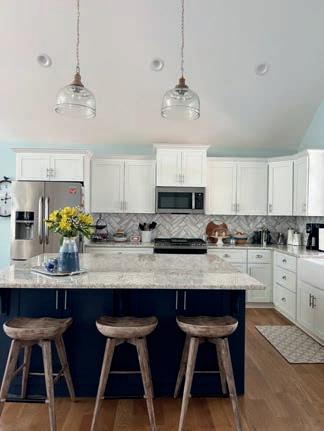

Springtime in the Blue Ridge Mountains is truly something special. April in the Roanoke Valley is spectacular! The Lenten roses, tulips, dogwood blossoms, you get the idea — all confirmation that a change of season is upon us. In that vein, this issue of HOME is bursting with inspiration inside and outside.
First, let’s get “sprouting,” as adding shoots and sprouts to your recipes can have healthy and tasty advantages. Honey is another addition to a healthier lifestyle. Read about nature’s liquid gold full of antioxidants and anti-inflammatory agents along with being a natural sweetener.
Pocket gardens are making a comeback — “found” green spaces that add so much to a neighborhood. Most often located in urban settings, the pocket park becomes a sliver of possibilities embraced and nurtured by a community and can deflect urban blight and bring pride to an otherwise desolate area.
Also, Kendall Livick helps us find our inner-designer style. Find out what you love, and make the most of your designer instincts. Maybe you know what you are ready to acquire but do you know when to save or when to splurge? We’ve got great advice to make sure you spend (or save) with confidence!
April in Virginia also means Historic Garden Week, and this year’s tour in Roanoke is set for Saturday, April 27. Lakewood Colony is a little-known neighborhood in the Southwest sector of Roanoke City. Fun fact: My first visit to Roanoke in the late ’80s was to Lakewood, as the young man I was dating grew up

there, and it was time for me to meet his parents and see his hometown. Well, I fell in love with Lakewood Colony (and later the young man too, who became my husband). The homes and gardens on tour will capture your heart as well. Preview the Roanoke tour in this issue and purchase your tickets locally at Townside Gardens or online at vagardenweek.org.
Spring in southwest Virginia is a bountiful and abundant feast for the senses. Enjoy the color, the fragrance and the warmth of renewal as the Roanoke Valley springs forward!
As always, thank you for reading.
Anne Marie Poore | annemarie@jamesrivermedia.com








Shelley
Becky
Martha
Jerry
Kendall
Ginny
Lisa


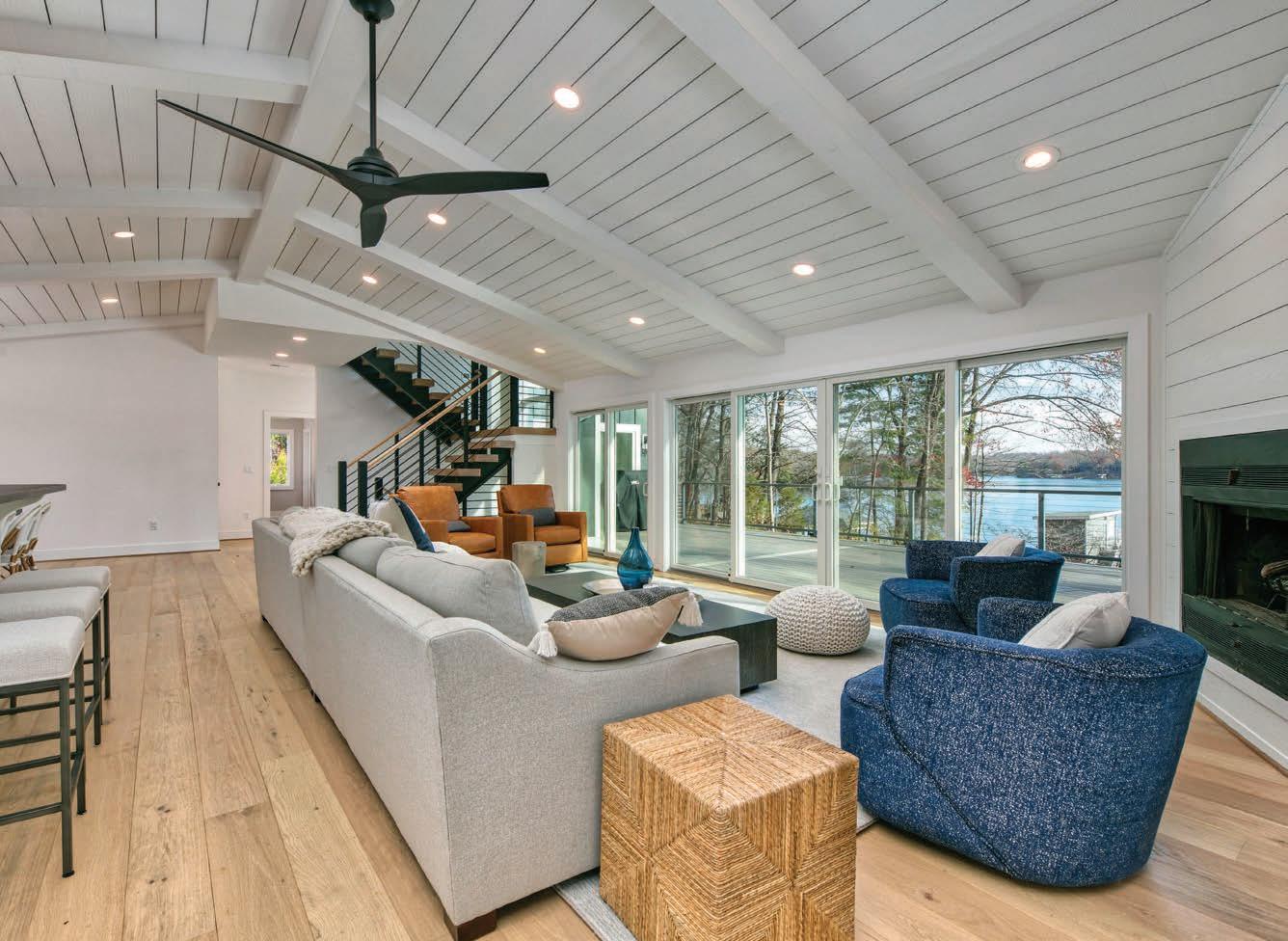
As you plan your marketing strategy, meet with your James River Media team to engage a wider audience with HOME magazine. Our distribution reaches the clients you need who have disposable income and who want your expertise!
Let’s partner to boost your business. And you can experience success like Better Sofas, British Swim School of the Roanoke Valley, The Little Gallery and Bass Sod Farm.

“We’ve been using HOME magazine to reach our customers for more than 10 years now. Every time we’ve been given the option to renew the advertising agreement, it has been one of the easiest decisions we’ve made. HOME is a diverse publication that always feels fresh and innovative. Without a doubt, it reaches the readers that we want to earn as our customers. And it does so without feeling like a pushy, invasive advertisement. It is not only a tool to reach new customers, but I also enjoy reading each article myself.”
Colby Rorer | Co-owner Better Sofas
“As a small business owner, I know that marketing is an integral part of success especially when growing a new business. I am thrilled that HOME magazine has helped British Swim School-Roanoke Valley get in front of numerous families and potential customers in the Roanoke Valley. The HOME magazine reach is undeniable and unmatched, in my opinion. To be alongside other high-quality and well trusted brands in the community is invaluable! I am excited to continue to work with them and reach as many potential customers as possible, as we spread our word about water, safety and survival swim lessons in the Roanoke Valley!”
Alice Ann Clark | Franchise Owner British Swim School-Roanoke Valley
“We have been advertising with HOME magazine for over a decade because we feel HOME provides the perfect approach and branding we need to reach art enthusiasts looking for quality art. … HOME magazine’s distribution volume and quality is far above other print advertising options, and the results have been demonstrated over and over again. We only advertise with HOME magazine due to the reach in Roanoke, Central Virginia and Smith Mountain Lake editions. Our customers have mentioned on numerous occasions they chose to shop with us due to seeing us in HOME magazine.
The Roanoke Valley HOME magazine highlights businesses in the area and Historic Downtown Roanoke, and we are grateful to be in the center of it all. HOME magazine encourages readers to make The Little Gallery a destination.”

We’ve had a lot of feedback from folks who have seen us in HOME magazine, and we actually got a call off our very first ad, which turned into a job that paid for a whole year’s worth of our advertising. Needless to say — we are very pleased with the results. The creative team at James River Media has also done a wonderful job helping us to design and create our ads. We are now advertising in all three versions of HOME magazine (Roanoke Valley, Central Virginia and Smith Mountain Lake) and we’re 100% glad we did go that route.”
W.B. Bass | Owner Bass Sod Farm



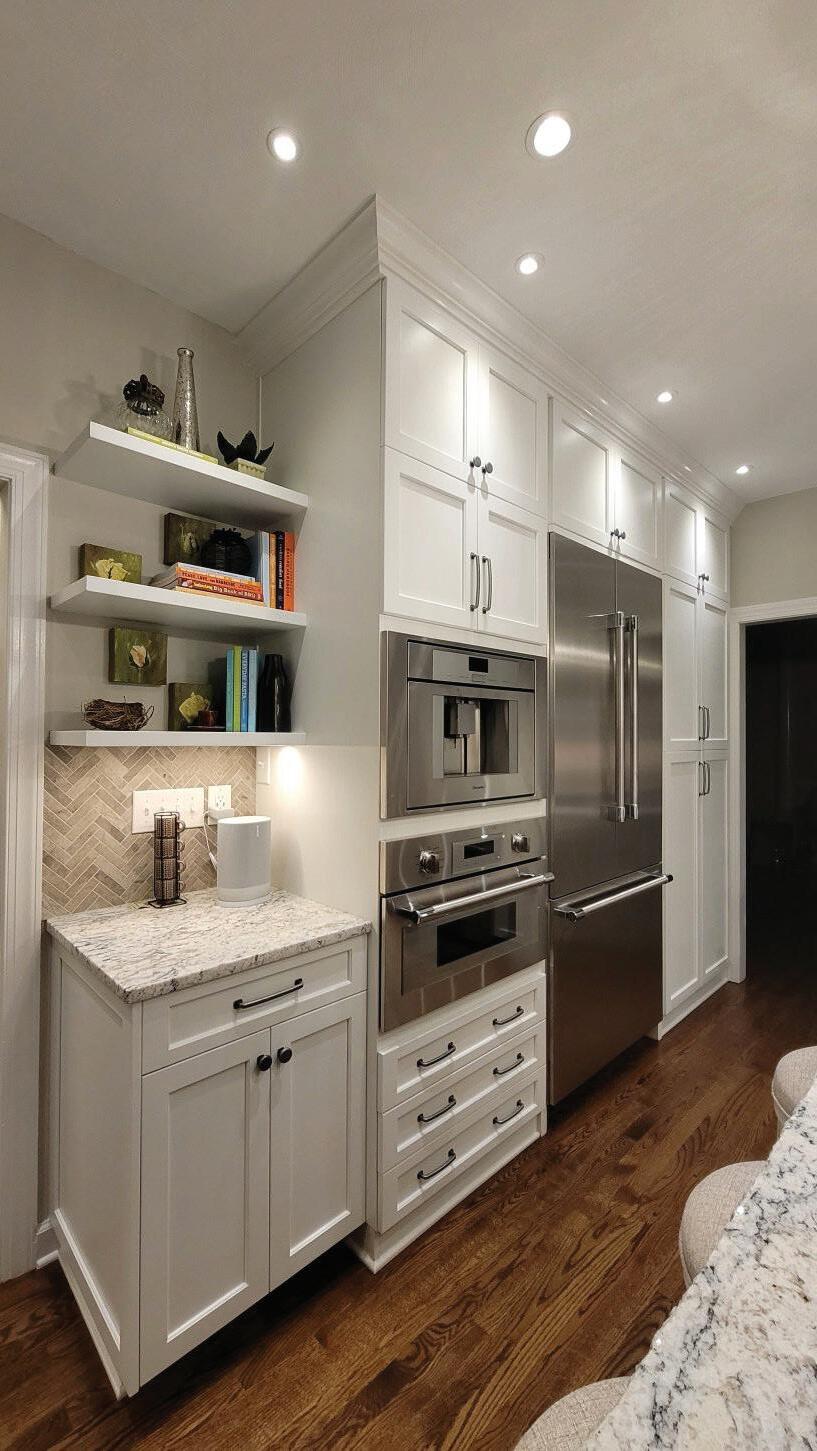


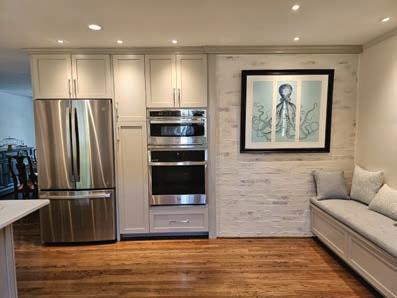


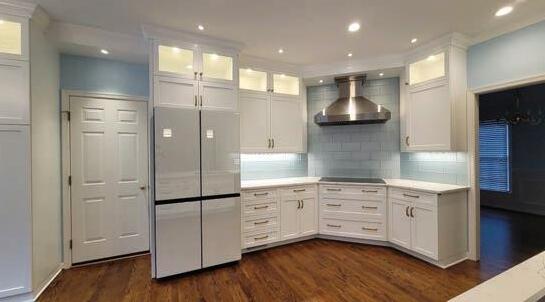








More than just a natural sweetener, honey has been used for thousands of years for its sweet flavor and its medicinal benefits. Whether you pour it on your pancakes or rub it onto a burn, honey is a household staple that no home should be without.
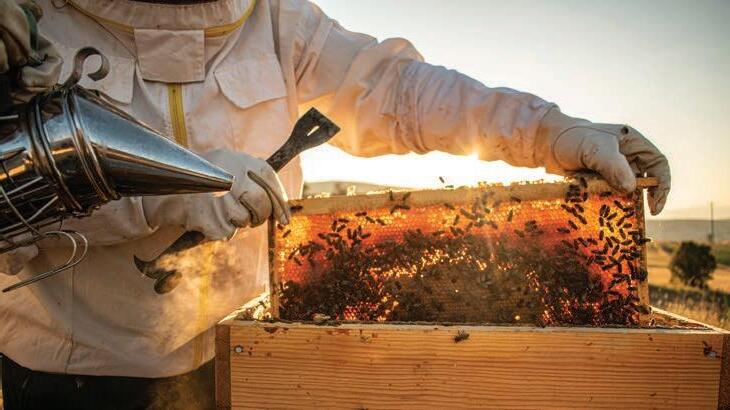


When the weather warms and plants begin to flower, honeybees leave their hives to gather nectar and pollen and then return for the process of making honey. “Bees will travel 2 to 5 miles from their hives to collect nectar,” notes Ann Zudekoff, member of the Piedmont Beekeepers and the Peaks of Otter Beekeepers. “They always return to the hive they left.”
Back at the hive, these busy bees deposit the nectar into honeycomb cells. They then fan their wings to extract the excess water and seal the cells with a waxy substance. Beekeepers remove the waxy substance and scoop out what is now the honey. A single bee produces about 1/12 of a teaspoon of honey per lifetime, which is only about 5 to 6 weeks. With proper care, a typical hive may yield about 50 pounds of surplus honey per year.
“A pound of honey is about a cup and a half,” notes Zudekoff. “Honey has a reputation as being a food that never spoils. While it’s true that honey will last, you’ll never get better honey than the day it comes out of the hive.”









Who you choose to finance your home with can make all the difference in your overall experience.




If you’re simply stirring a teaspoon of honey into a mug of hot tea, the flavor of each specific type may be lost. To really note the individual essences, try spreading some honey on a piece of toast or a biscuit or just spoon a bit right out of the jar! Since honey comes from the nectar of plants, there’s simply no way to quantify the variety available. Each plant contributes unique flavors and colors, from light to bold in taste, from yellow to brown in color.
According to Rob Howard, Virginiacertified master beekeeper of the Blue Ridge Beekeepers Association, “This area is known for sourwood honey. It’s an excellent, award-winning honey. If you’re looking for a light honey, black locust or clover is a good choice. Buckwheat is a bolder, darker honey.” If you want to try a variety of honeys, Howard suggests attending a bee club meeting in your area. Many clubs will offer an annual tasting event and members often bring their own honey to meetings to share with attendees.
Much of the honey in this area is wildflower honey. A subtle, sweet honey that’s good in teas, wildflower honey is wonderful paired with sharp cheddar cheese on a charcuterie board. Other flavors to look for: lavender, sage, orange blossom, dandelion and alfalfa.
Pure honey is tasty on its own, but infused honeys are interesting, flavorful treats as well. You’ll find honey infused with bourbon, spices, herbs, fruits, vegetables, and more to provide a unique taste and offer wide appeal. “Hot honey” has become a fad in recent years. Spicy peppers are added to the sweet liquid, resulting in a spicy/sweet combination that gives your taste buds a thrill.

In addition to its use as a natural sweetener and a delicious treat, honey also has a reputation for medicinal value. Many people like honey for its effect on seasonal allergies. Since bees collect nectar and pollen from trees and plants, you can introduce yourself to the allergens a little at a time by enjoying local honey. Thus, when everything is in full bloom, allergy symptoms may not be as severe.
Rich in antioxidants, antibacterial and boasting antiinflammatory agents, honey has been used for centuries as home medicine to treat a variety of acute and chronic illnesses. Honey has a positive impact on blood pressure and cholesterol levels, and when compared to white sugar, honey has a smaller effect on blood sugar in those with diabetes. Honey also improves gut health; it doesn’t ferment in your stomach like refined sugars do.
According to Howard, “People often use honey for a simple sore throat or for even serious wounds and burns. Honey is a

contact antibacterial substance,” he explains. “It kills bacteria and keeps wounds clean. Burn patients are given bandages that have medical-grade honey on them to promote healing.” Honey can even be rubbed on rashes to reduce skin irritations. It is important to note that ingesting honey is not recommended for children under the age of 1.
As with any purchase, “It’s important to read labels,” notes Howard. “My advice is to stay away from imported honey because it has some metals or corn syrup that shouldn’t be there. Some imported honey is good, but you really have to be careful. At a large box store or a grocery store, you may not be getting what you want. Do your research!”
Howard recommends buying the honey at local farmers’ markets and directly from the beekeeper. Also, look for a local apiary, a location where hives of bees are kept. Apiaries vary in size from a hobbyist’s hive to a commercial operation.
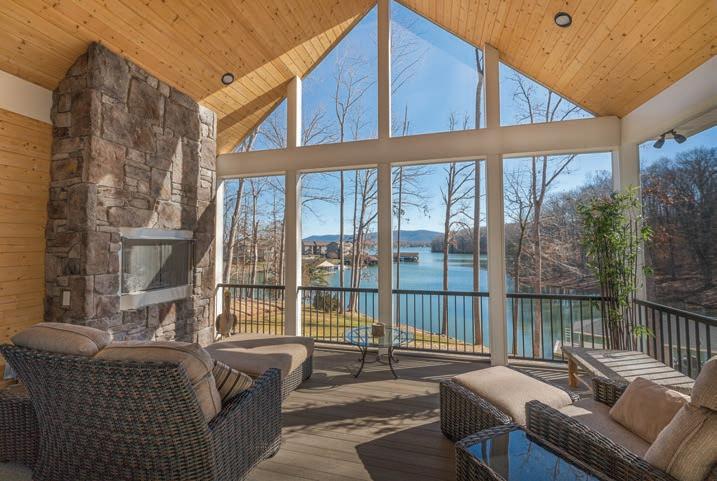


4 medium pears
3 Tablespoons of honey
2 Tablespoons of butter
1/2 teaspoon vanilla extract
1/2 teaspoon cinnamon
Preheat the oven to 400°F. Peel pears with a vegetable peeler, cut off the ends and then halve the pears. Scoop out the core. Place the pears face down in a glass baking dish. In a small bowl, combine the honey, cinnamon, vanilla and butter and heat in the microwave for 30 seconds. Pour half of the sauce over the pears. Bake for 25 minutes until soft and slightly brown. Pour the remaining sauce over each pear before serving.
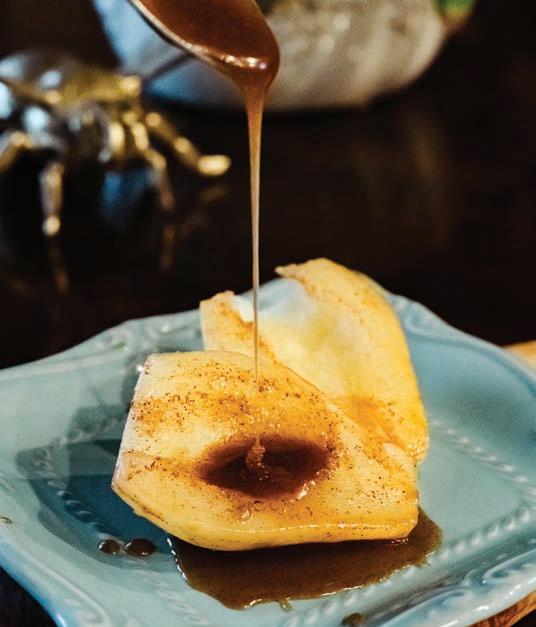
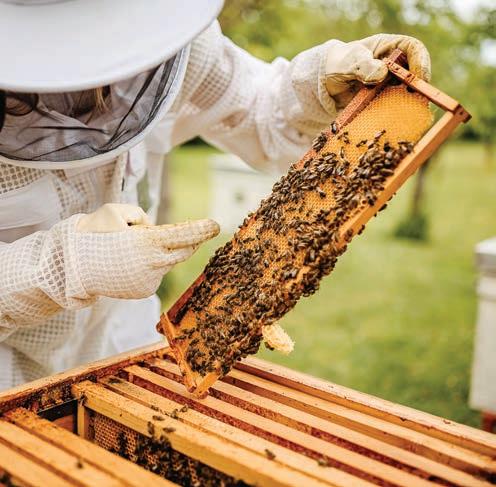

If you’re interested in beekeeping, organizations like Piedmont Beekeepers and Blue Ridge Beekeepers are great places to start. Starter kits for beginning beekeepers are sold for around $200 and come with everything needed for the initial colony.
Zudekoff was careful to warn first-time beekeepers. “There’s a reason we call it beekeeping and not honey collecting,” she laughs. “That first year, the emphasis is really on growing your colony. Lots of factors go into actually being able to harvest honey: the strength and health of the colony, the weather, the beekeeper, a little bit of luck. It’s different every year. The focus is really on the bees and, if you get honey, that’s a plus.”
The Virginia Beekeeping Teachers Consortium conducts classes annually through local clubs for those wanting to become beekeepers. Even if you’re not interested in beekeeping, you can positively impact the honey supply by planting nectar and native pollinator plants in your yard.
Nutritious and delicious, honey can be stored on your table and enjoyed in recipes or straight out of the jar. Its yummy goodness combined with its medicinal uses will make you want to head right down to your local farmers’ market. ✦
 BY KATHERINE FULGHUM KNOPF
BY KATHERINE FULGHUM KNOPF
The Old Southwest neighborhood, long known for its striking architecture and historic houses with formal landscapes, has added another charming element to its community: The Day Avenue Pocket Park. Once an ugly lot full of invasive weeds, this mini-park now invites residents to stop and stay awhile.

From easy access to Roanoke attractions to rolling hills and mountain views, The Glebe combines the best of Blue Ridge living into the region’s premier nonprofit Life Plan Community. Here, you’ll be surrounded by friends and opportunities to pursue what matters most to you. You’ll enjoy maintenance-free living with services that make life easier and amenities that make it a lot more fun. And you’ll have
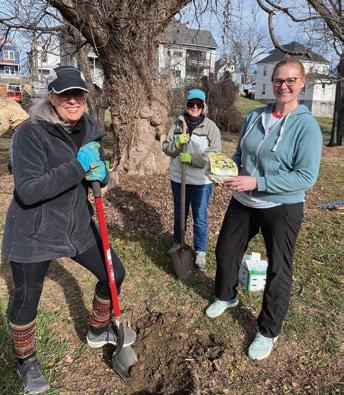


• Bring your entrepreneurial spirit and creativity to your work!
• Enjoy a flexible full- or part-time schedule working from home.
• Help your favorite businesses build their audience.
• Be part of a growing company that promotes the local community.
• Hit the ground running working immediately with some of our current advertisers.
• Unleash your potential — the more you sell, the more you earn!
A storied past Pockets parks, known as mini-parks or parkettes, originated in Europe after World War II as a movement to reintroduce beauty into the cities after the devastation of bombings. Pocket parks’ small scale allows community citizens to contribute their labor and talents to restore the land using lowcost materials and donations. Often plants come from neighbors’ gardens or civic-minded businesses. These disused parcels benefit both public and private entities; the lot’s owner sells or donates the plot to the neighborhood in exchange for local residents maintaining the land.
In the 1950s, pocket parks came to the United States. Washington D.C., Baltimore and Philadelphia adopted the pocket park concept to improve their urban spaces. Landscape architect Karl Linn advocated converting overgrown, vacant city lots into miniparks to restore the health of these large municipalities. Creating common areas for citizens to gather and meet neighbors, to relax or to exercise builds community relationships and reduces urban blight.

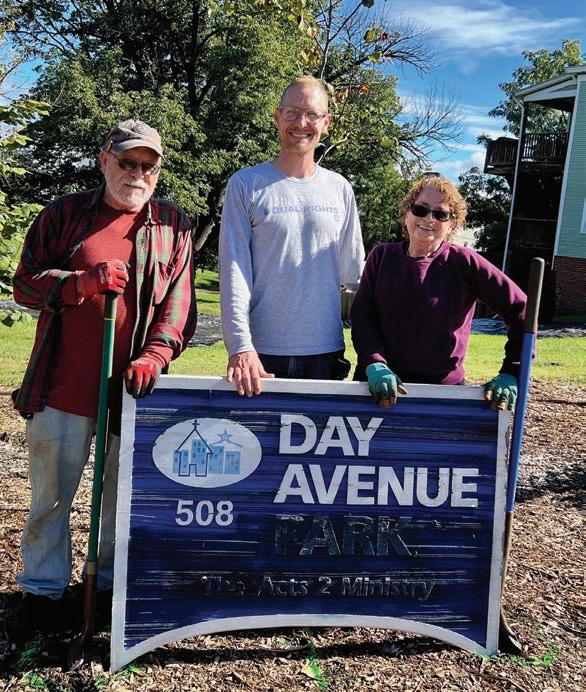
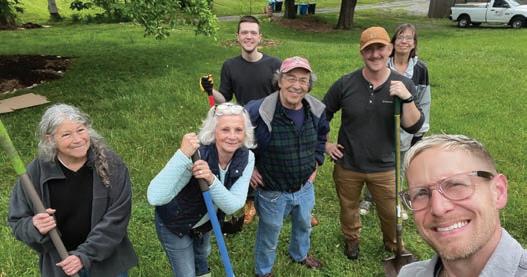
The corner lot on Day Avenue was a problem spot just a few years ago. Now the neighborhood association, in partnership with Roanoke City and Garden Vitals, has transformed the overgrown lot that once required time and money for mowing into a green space filled with three redbud trees, vibrant daffodils and shrubs.
Creating designated green spaces restores municipalities in several ways. Trees and plants absorb heavy rain waters, which aids stormwater runoff issues. An open space with planned foliage increases the quality of the community and potentially steps up property values. A public park in a neighborhood offers a place for residents to unwind, and this leads to improved mental health. It brings civic leaders and locals together in a space for neighborhood gatherings and offers children a place for outdoor play close to home.


Tips for establishing a pocket park
n Vacant, irregular shaped lots or pieces of land that are not easily buildable offer good locations for a pocket park. Unkept public spaces such as medians offer potential. Determine ownership and ask permission to improve it.
n Decide on the park’s purpose — benefitting the environment, providing a recreation space or creating a hands-on gardening space (or a combination) — to give structure to the proposal.
n With the help of a Master Gardener or Garden Designer, draw a plan for the space. Make a written timeline so the pocket park can grow in stages.

n Organize a neighborhood meeting or ask to be on the agenda of the neighborhood association in your area. Identify interested participants.
n Ask neighbors to sign up for various workdays and committees that will oversee the project.
n Select native plants that are low-maintenance and support pollinators and wildlife. Visit this website for plant ideas: plantvirginianatives.org/ plantswvanatives/plant-swva-natives-guide
n Vegetation markers and signage educate visitors and encourage participation.

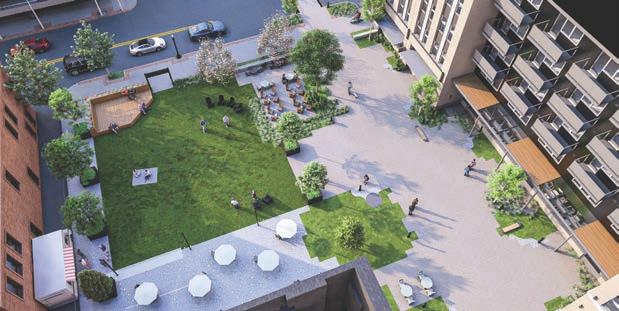
A one-acre lot in downtown Roanoke is slated to become the next pocket park this summer. Situated next to The Bower, a new upscale apartment building between Campbell Avenue and Salem Avenue, the park will provide greenery in an urban setting that is heavy on concrete and dirt. The plan is to build a courtyard, then surround it with grass and trees. Adding outdoor furniture, a stage for performances and back walls for art or murals will encourage residents and tourists to visit. This pocket park will provide a great spot for picnics, relaxing and outdoor events.
Energetic locals succeeded in living up to their park’s motto: Growing Together in Old Southwest. Starting in December 2022, neighbors covered areas of the lot in old newspapers (lasagna gardening) to kill the weeds naturally so there was a place for flower beds of asters and coneflowers. Sharon Burnham of Garden Vitals designed the garden and helped install trees and shrubs in October 2023.
The neighborhood’s vision shaped a park that attracts pollinators and educates citizens. At Burnham’s suggestion, volunteers planted four arborvitae and berrying shrubs to establish the park’s boundaries — a living hedge that provides privacy and draws birds to the garden. In December 2023, Star City Garden Club and Town & County Garden Club donated and planted 300 crocus and daffodil bulbs for colorful spring flowers they hope will induce neighbors to come see what is blooming.
Mary Anne Mather, co-lead of the Pocket Park Project and Old Southwest board member, observed that the effort is a perfect example of Margaret Mead’s famous statement: “Never doubt that a small group of thoughtful, committed citizens can change the world: Indeed, it is the only thing that ever has.”
Terry McGuire, vice president of Old Southwest Inc., is the other co-lead of the project. He says Day Avenue Pocket Park creates a natural opportunity to build community through education. The gardening workshops bring people out to learn and offers a chance for neighbors to get to know each other. Plant days teach neighbors about growing natives and supporting Bee City tenants. The Day Avenue Pocket Park provides a place for all ages to enjoy the outdoors. ✦

In the ever-evolving world of interior design, accent lighting has emerged as a pivotal element in creating ambiance and highlighting key features within a space. Among the myriad lighting options available, accent lighting stands out as a versatile tool to highlight architectural features, illuminate artwork or simply add ambiance to a room. In this article, we delve into the current trends in accent lighting and offer insights on how to choose the perfect accent lighting to complement your design style, size constraints and functional needs.




As we look at 2024 trends, accent lighting styles continue to evolve, reflecting a fusion of contemporary aesthetics with a nod to timeless elegance. One notable trend dominating the scene is the resurgence of vintage-inspired designs. Retro-chic lamps featuring brass finishes, sleek silhouettes and artful detailing are making a comeback, adding a touch of nostalgia to modern interiors.
Additionally, eco-conscious consumers are gravitating toward sustainable materials and artisanal craftsmanship. Handcrafted lamps made from reclaimed wood, recycled glass or sustainable metals not only elevate the visual appeal of a space but also contribute to a more environmentally friendly design ethos. Also, minimalist designs remain ever popular, characterized by clean lines, geometric shapes and understated elegance. These sleek and streamlined lamps seamlessly integrate into contemporary interiors, providing a subtle yet impactful accent.

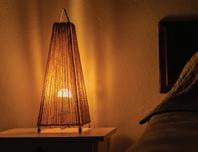
Accent lighting is a powerful tool for enhancing a room’s design style. From minimalist to maximalist, there’s a lamp for every preference.
n Minimalist marvels. For those favoring a minimalist approach, sleek and understated designs take center stage. Think slim, monochromatic lamps with clean lines and geometric shapes. Matte finishes in neutral tones are particularly trending, seamlessly integrating into contemporary spaces.


n Vintage vibes. Vintage and retro styles continue to make a comeback, influencing lamp designs with a touch of nostalgia. Look for fixtures with brass or copper accents, tapered shades and iconic mid-century modern silhouettes. These lamps not only provide warm, ambient light but also serve as a nod to design eras of the past.
n Eclectic elegance. The eclectic style embraces diversity, allowing for a mix of patterns, textures and colors. Lamps in this category often feature unique materials, bold colors and unconventional shapes. Experiment with mismatched lamps that complement rather than match, creating an engaging visual tapestry within the room.
Selecting the right-sized lamp is crucial in achieving a harmonious balance within a room. Oversized lamps can overwhelm a space, while undersized ones may fail to make a visual impact. Here are some guidelines to consider:
n Proportional placement. In larger rooms, opt for taller lamps with broader bases to fill the space effectively. Conversely, in smaller spaces, lean toward compact and slender designs to avoid crowding.
n Visual weight. Consider the visual weight of the lamp in relation to its surroundings. A lamp with a heavy, ornate base may require a larger room to maintain equilibrium, while a lighter, airy design can complement more confined spaces.
n Functionality & placement. Beyond aesthetics, the lamp’s intended function should guide its size selection. A bedside table lamp, for instance, should be proportionate to the nightstand, while a floor lamp in a reading nook should provide sufficient light without overpowering the area.
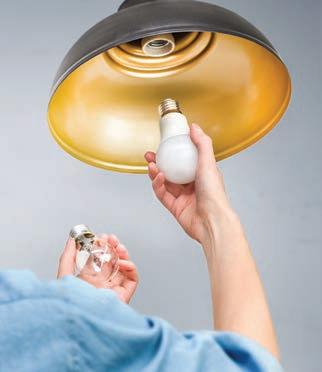


In an era of increased environmental awareness, sustainable lighting options have gained prominence. Designers and consumers alike are seeking eco-friendly materials and energyefficient technologies in accent lighting.
n Energy-efficient LED lighting. LED technology continues to advance, offering energy-efficient alternatives to traditional incandescent bulbs. Lamps equipped with dimmable LED lights not only save on energy costs but also allow users to adjust the ambiance according to their preferences.
n Recycled materials. A growing trend in lamp design involves the use of recycled and upcycled materials. From lamp bases crafted from reclaimed wood to shades made from recycled fabrics, these environmentally conscious choices contribute to a more sustainable design ethos.
n Smart lighting integration. The integration of smart lighting systems provides users with unprecedented control over their accent lighting. From adjusting color temperatures to setting automated schedules, smart lamps cater to the tech-savvy while also contributing to energy conservation.
As the demand for personalized living spaces continues to rise, customization options in accent lighting have become more accessible. Brands are offering a range of choices, from customizable lampshades to bespoke finishes, allowing users to express their unique style.
n Mix & match. Embrace the mix-and-match trend by selecting lamp bases and shades separately to perfectly align with the overall design of the room.

n Personalized finishes. Many manufacturers now offer customizable finishes for lamp bases, providing a unique touch that complements existing furniture and décor.
n DIY lampshade revival. Give old lamps a new lease on life by revamping the lampshade. DIY enthusiasts can explore various fabrics, paints and embellishments to create a one-ofa-kind accent piece that reflects their personality.
While lamps remain a popular choice for accent lighting, there are several other accent lighting options to explore, each offering its own charm and functionality:
n Wall sconces. Ideal for illuminating hallways, accentuating architectural features or framing artwork, wall sconces come in a variety of styles and finishes.
n Pendant lights. Perfect for adding drama and visual interest to dining areas or kitchen islands, pendant lights offer both ambient and task lighting while making a bold style statement.
n LED strip lighting. Versatile and energy-efficient, LED strip lighting can be used to highlight architectural elements, create backlighting for shelves or cabinets or add a modern edge to furniture pieces.
Accent lighting serves as the pièce de résistance in interior design, elevating the ambiance and functionality of a space while reflecting personal style preferences. By staying attuned to current trends, considering design style, size constraints and functional requirements, you can effortlessly choose the perfect accent lighting to illuminate your home with flair and finesse. So, let your light shine! ✦

The Woods Family includes four generations of expertise, providing the Roanoke Valley and Botetourt areas with the highest quality and value in heating and air conditioning service for decades. Our family involvement dates back to the 1950s. That longevity of excellent service puts us at the forefront whenever someone wants a recommendation for heating and AC services for their home.
In western Virginia, there are few things held in higher esteem than family and family traditions. People in the area look for quality and value in their services. We o er a 100% guarantee on all of our services, from tune-ups and service repairs to new equipment installation and replacements. We also o er 24/7 emergency services, letting our customers rest easy knowing we can handle any problem, day or night. Start a new family tradition today by reaching out to see how we can help with your heating and AC needs.


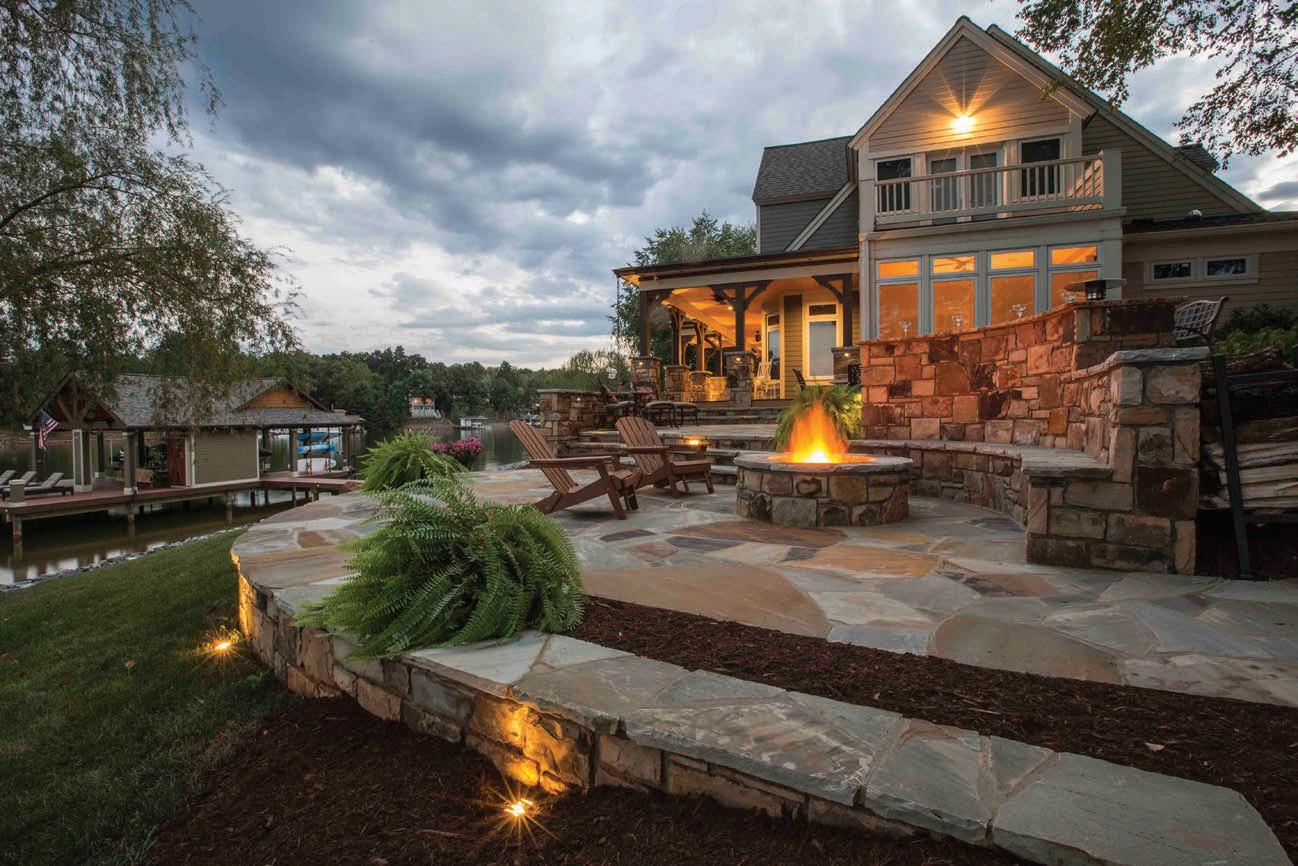
2024 is an important year for local Class A contractor GroundScapes, as it marks their 20th year in business! GroundScapes President James Edwards says that two decades of successful contracting is an important milestone, and he is very thankful for all the people who have made the company a success.
“Not only do we have amazing customers, but we also have the best employees I could dream of. I sincerely love all of the people that have made these 20 years so special!” Edwards says.
If you have driven around Roanoke or Smith Mountain Lake and seen a breathtaking oasis in someone’s backyard that would rival any fivestar resort and make your jaw drop, there is a high probability that you have seen a GroundScapes project! GroundScapes is known to Roanoke for its amazing Outdoor Living Areas and Resort Style Backyards, but they are experts with much simpler landscape and hardscape installations also.
“Our specialty is certainly custom resort-style backyards with outdoor pavilions, decks, patios, pools, spas, fireplaces, outdoor kitchens and so on,” Edwards says. “But it takes a good mix of projects for us to maintain an efficient work schedule for our crews, so we appreciate the small jobs equally as much as the bigger ones!” He adds that although there is certainly a cost associated with the upscale backyard living area projects GroundScapes specializes in, most of our clients end up saving thousands of dollars per year on vacations. The reality is that they would rather just stay home after we have designed and installed a backyard project for them!





When asked about the biggest changes in the industry in the past 20 years, Edwards says, “These days there are a lot more inexperienced competitors underbidding and not understanding the complexity of these types of projects. There’s a lot going on with these elaborate residential construction projects, and there simply just aren’t many contractors in our area with the capabilities, experience or the resources to execute them the correct way — and in a way that will allow them to hold up for years to come.”
“With our 20th anniversary here, I want our customers to know how much they mean to us and how much we appreciate them. Without them we just wouldn’t be here, and we wouldn’t be the well-oiled machine we are today!”


 BY KENDALL ATKINS LIVICK
BY KENDALL ATKINS LIVICK
If you’ve ever wondered why certain décor styles appeal to you, while others don’t, personality archetypes may hold a clue for this mystery. Examples of famous personality type tests, include the Myers-Briggs, The Big Five, Human Design and the Enneagram. This three-part series focuses on the latter and the archetypes that embody the philosophy. This first installment will cover numbers 1-3.
The Enneagram is based on an ancient system that has roots in a variety of religions, including Christianity, mystical Judaism and more. The theory describes nine categories of personality we see in our midst. If you don’t know your type and want to find out, you can find a test online. You may recognize yourself in one or more of these numbers, and personality typology could be one more tool to nail down your personal design. 1 2 3


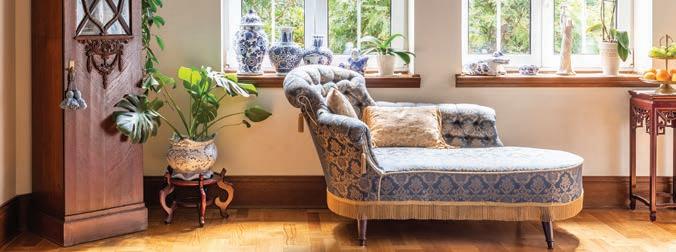
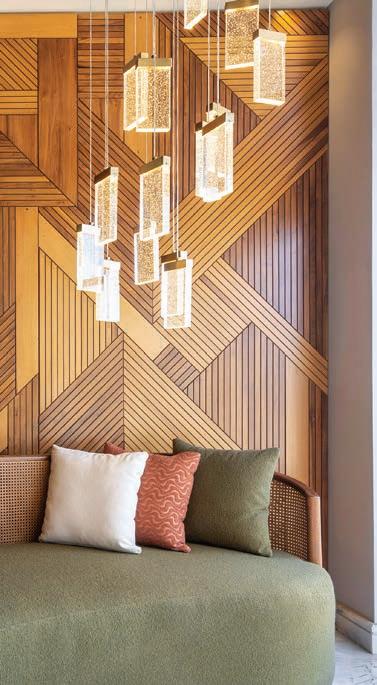



1
Ones, the reformers, are logical and always ready to live in alignment with their principles and ideals. They are intentional in their way of life, self-disciplined and perfection seeking. They want to live in a way that is objectively virtuous and correct.
2
Twos, the helpers, are the natural caretakers of the world. As born hosts and hostesses, they come across as warm, giving, nurturing and inviting. They want to make others feel adored and accepted, and they may have a tendency to become territorial or overprotective of those they love.
3
Threes, the achievers, are ambitious, driven, success-seeking and focused on image. They chase their big dreams and are highly motivated to hustle in pursuit of the next goal. They want to challenge themselves and perform well to impress others and gain admiration.
4 Fours, the individuals, are the sensitive artists of the world. Fours can express themselves in dramatic ways, experience mood swings and come across as melancholy. Yet, they are old souls with a poetic flair.
5
Fives, the investigators, are intellectually curious, highly intelligent and typically introverted. They are passionate about researching their areas of interest and prefer to spend much of their time in solitude, in order to process their thoughts and manage their energy.
6
Sixes, the loyalists, are community-oriented and relationship-focused on their lifelong friends, family members and inner circle. They show up in our world as dutiful contributing citizens who embrace critical thinking. Although they can have a tendency to worry, they can also channel fear into creating security and preparing for a rainy day.
7 Sevens, the enthusiasts, are focused on the pursuit of fun and adventure. They are flexible, yet difficult to pin down at times, due to their scattered nature. They focus on positivity and finding the silver linings in life. If times get rough or intolerable, they yearn to flee to greener pastures.
8 Eights, the challengers, are tough bulldozer types who wield power and force. They are full of confidence, competence and determination. They also do not shy away from confrontation and tough conversations. Instead, they address conflict head-on with an assuredness of victory.
9 Nines, the peacemakers, are sometimes referred to as the “sweethearts of the Enneagram.” With their good-natured vibes, they tend to go with the flow. They are pleasant to be around, affirming toward others around them, naturally empathetic and accommodating. They go along to get along and have an air of natural lovability about them. 1 2 3

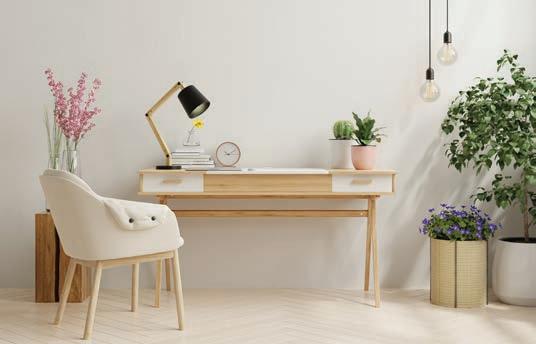
ones are
a
with their ideals. Whatever their brand of excellence, you will see evidence in their home. You might walk into a home gym, where they work up a sweat if fitness is their thing. An office will reveal career ambition. Their kitchen could be stocked with healthy, organic food if healthy living is a cause they support. While visiting a one, you will likely admire their integrity and pursuit of their goals. They embody selfdiscipline and a principled life. Don’t be surprised if you leave with a few new goals to pursue and moral perspectives that may or may not lead to a complete change in lifestyle.








If you identify as a one, you probably have an eye for precision and tend to prefer clean lines and minimalism. Classic architecture, neutral colors, open floor plans, natural light pouring in through the windows and high ceilings offer plenty of space to rest and anchor the thoughts in a busy mind. You’ll

Tasteful two
Twos are the quintessential hosts. If any of the archetypes know how to roll out the red carpet for guests with big love, it’s a two. Embellishments that are extra special and bring about a sense of nostalgia are typical in their homes. A displayed quilt that honors ancestors, for example, or relics passed down the family tree, will be proudly presented. Displayed pictures of loved ones are a guarantee. Depending on other personality factors, where they fall on the minimalism versus maximalism scale may vary. Either way, their home is guaranteed to feature some element of traditionalism. Extra special touches of hospitality, such as a coffee bar, quick snacks and a general flow pattern in the kitchen for quick and easy navigation can be expected. They will be less likely to turn away unexpected company, and they will immediately snap into the role of host even when surprised. When visiting a two, guests feel wrapped in a warm hug. In their home, you will feel like you can immediately relax into the atmosphere. It will mean the world to them if you reciprocate and pull out some extra stops the next time they visit you!

want to highlight your intellect, so be sure to have built-ins for awards or a gallery wall for diplomas and certificates. Many ones are into green living and may be drawn to the biophilic design style. If this sounds like you, check out Scandinavian, Japandi and Industrial design styles for some one-derful inspiration.
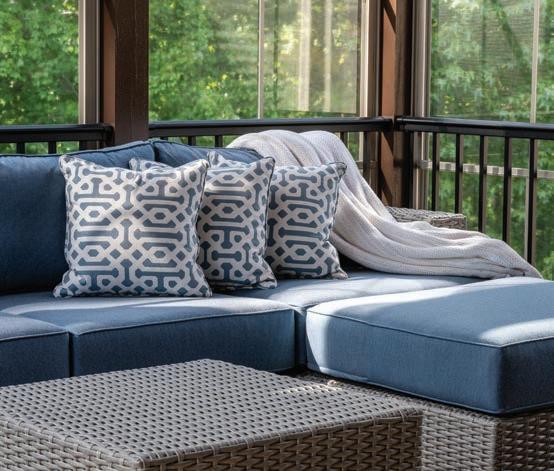











Thematic three
Threes are most likely to have a specifically curated look to match their aesthetic vision. Image-conscious with an eye for style, threes have an eye toward the future. They tend to gravitate to a contemporary style with bold patterns. Their homes are likely to feature large statement light fixtures and lots of modern art adorning their walls. Threes also won’t be shy to incorporate bright, contrasting colors. Although this group isn’t as traditional or nostalgic as twos, they might harken back to days gone by if it’s a new spin on an old style. If you visit a three, you will feel impressed by their fast-paced lifestyle and ability to stay ahead of trends. Threes are go-getters who always have their sights set on the next accomplishment. They want to make the most of their lives and push their potential to the brink. Whether it’s a hobby, a chosen vocation, a pet project or a personal passion, they strive to be the best of the best and always on the receiving end of applause. Because of the boundary pushing nature of the threes, it’s not uncommon for them to take on hefty renovations to accommodate a new passion or goal. Imagine the new rock climber constructing a climbing gym in the attic, or the aspiring botanist creating an elaborate landscape in the front yard. For this reason, the spotlight usually finds them.
If you identify with this group, you’ll most likely highlight many wow factors in your home. Pops of color will capture the eye of onlookers, and the latest styles and trendy touches will be the name of the game, as these different elements and knickknacks compete for attention. If this sounds like you, seek inspiration in Contemporary, Postmodern and Art Deco design styles.
Join us in the next issue to continue the fun with types 4-6. ✦
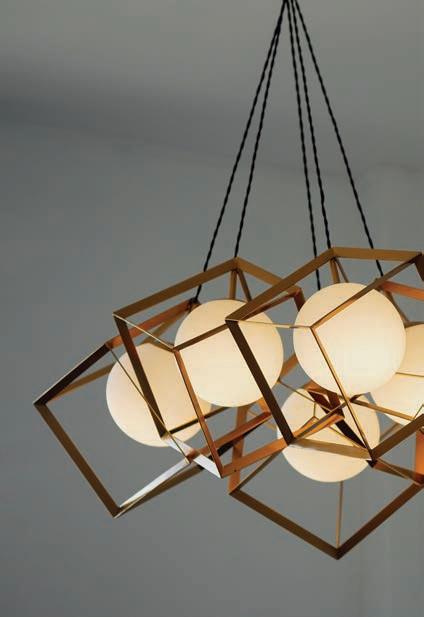

 BY JERRY HALE
BY JERRY HALE
With the steady growth in the number of hybrid and all-electric cars, trucks, vans and SUVs being offered by U.S. and overseas automakers, more and more vehicle buyers will be considering whether “juice” from the power grid should replace all or part of the gasoline they’ve been purchasing.
Just imagine: Pull into the garage, connect the car to the on-wall charging station and head inside. A few hours later, your ride will be “fueled” and ready to go. With an 80- to 330mile, full-charge range (depending on make and
model), an all-electric vehicle (EV) is more than adequate for most Americans’ daily driving needs – estimated at just 30 miles by AAA.
For that vignette to play out, however, drivers must be able to charge their EVs at home between trips. EVs typically come with a charging cord that can be plugged into a standard 120-volt outlet. But for the faster charging times that most EV owners prefer, their garages must be equipped with a Level 2 charging station – hardly a DIY task unless one happens to be a master electrician.

Time to call in the experts
That’s where companies like Roanoke-based Southern Trust Home Services come into play. Project Manager Brandon Beck leads one of Southern Trust’s two teams that do EV charger installations. “We begin with an assessment of existing electrical service to the home,” Beck explains. “Residential Level 2 chargers, which can fully charge most EVs in eight hours or less, require a minimum of 200 amp service.”
Super-fast chargers – like those typically found at commercial roadside charging locations –require 200-400-amp circuitry. Charging time goes way down, but cost for the installation increases considerably.
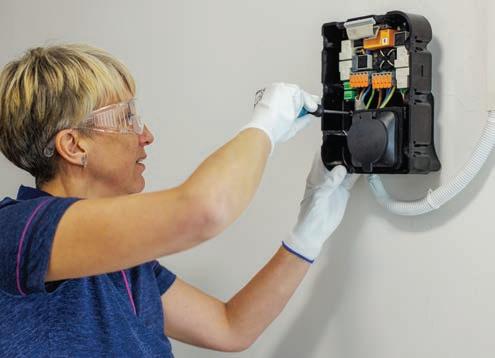

And while EVs typically come with a charging cord that plugs directly into an existing 120-volt outlet, that approach provides only a painfully slow charging rate and, worse, can create a fire safety hazard. Says Beck: “Installing a Level 2 220-volt charger means you’ll have built-in sensors that shut down the fast-charge once batteries are fully charged. Nearly all Level 2 chargers also enable the user to remotely control and monitor the charging process through a cell-phone app.”
Installing a Level 2 charger usually takes less than a day and costs around $2,500, including the cost of the charger itself. Cost goes up if the main electrical panel is located far from the charging location or if routing of the dedicated circuit is complicated or restricted. A federal tax rebate of up to $1,000 often applies, and certain localities offer up to 15 percent discounts on electricity the chargers consume during off-peak hours.
Most Level 2 chargers get hardwired into their circuit, but some can be plugged into a clothesdryer-style 220 outlet.
“We did about 75 charger installations in 2023 and expect that to increase this year,” Beck says. “And most new construction anticipates the likely future need for EV charging by including the necessary circuitry to the garage in the wiring plan.”
Is an EV right for me?
It depends. Car buyers should consider their own driving patterns when making that decision. Plug-in EVs are costly, with luxury models from the most respected brands commanding well over $100,000 when new. Economy-priced models are available, however, and advances in battery technology are steadily improving range, performance and longevity. EV batteries are typically covered by warranties lasting up to 100,000 miles.
The cost of installing homecharging capabilities should be rapidly offset by lower operating costs: AEP cites typical annual gasoline costs for driving a full-sized vehicle 12,000 miles, at average $3.59/gallon, to be $1,346. In contrast, an EV that gets charged at their off-peak rate will require only $422 in electricity.
Drivers who want to use EVs for road-trip travel may need to plan for necessary recharges along the way. Charging stations are becoming increasingly common at hotels/motels, rest-stop retailers and auto dealers as EVs become more popular, and apps are available to help you find recharge locations along the way. EV enthusiasts, it seems, rather enjoy doing the planning necessary for an extended drive. ✦


Grilled cheese sandwiches are so simple to make that it’s often the first thing many of us learn to cook. The ultimate comfort food, they round out a bowl of soup for a meal or can stand alone as a perfect snack. Crispy on the outside, gooey on the inside, grilled cheeses are endless debates as to how to best achieve the desired result of perfectly toasted bread and melted cheesy interior: sliced versus grated cheese, butter versus mayonnaise on the outside of the bread, exactly what type of bread is best and that’s not even getting into the best cheese debates.
You can get lost in the details, but the basic elements are sliced bread, cheese that melts easily and a wellgreased surface. Cook it over medium to low heat, so that the outside cooking process takes as long as the inside and voilà! The perfect grilled cheese sandwich.
There are any number of variations out there that can elevate the sandwich to higher levels. Adding jams, mustards, sautéed or roasted vegetables, meats, sliced fruit as well as experimenting with different cheeses make for a whole new take on grilled cheese. Make them with waffle irons or feed a crowd with sheet pan grilled cheeses, made en masse in the oven.
From basic to next level, here are a few recipes to get your creative grilled-cheese wheels spinning.




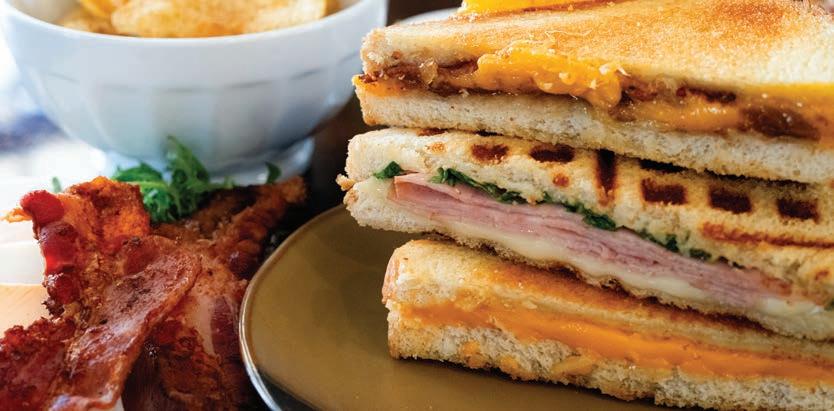
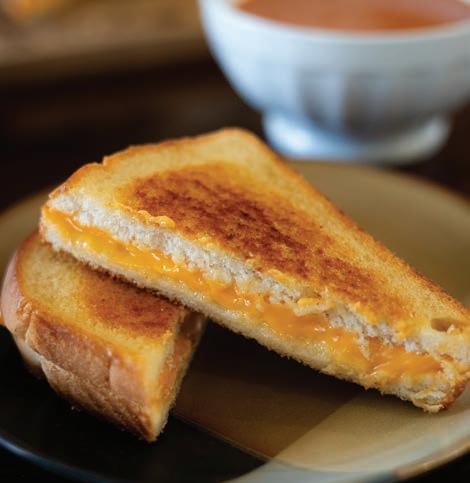
Restaurants, particularly diners, always have the best grilled cheese sandwiches. Their secret? Lots of fat on the bread, cooked over a low heat on a griddle, with a good melting cheese like American. If using mayonnaise on the exterior, coat it very thinly and smoothly. This is a time when you’ll want to use real mayonnaise; the low-fat versions or Miracle Whip will not produce the same results.
2 slices of bread
2-3 slices American cheese, white or yellow
Butter, softened, or mayonnaise
Heat pan or griddle over medium-low heat. Thinly spread one side of each slice of bread with butter (or mayonnaise). Place one slice buttered (or mayo’d) side down onto heated pan, and top with cheese. Place remaining slice, buttered side up, on top. Cook for about 3 minutes or until bread is toasty and brown. Turn sandwich over, and cook the other side until brown and toasty. Serve. Yield: 1 serving
Oven-Grilled Cheese with Bacon and Fig Jam
Sheet pan grilled cheeses make feeding a crowd fast work. Prosciutto or ham can substitute for the bacon here.
8 slices of bread
8 slices of cooked bacon
Fig jam
8 ounces of sharp cheddar cheese
Butter
Preheat oven to 375°F. Spread one side of bread with butter. Put four slices, buttered side down, on a cookie sheet. Thinly spread fig jam on bread, then add 2-3 slices of cheese. (Alternatively, you can use grated cheese here — a handful of grated cheese is about an ounce.) Add two slices of bacon and remaining slice of cheese to each piece of bread. Cover each sandwich with remaining slice of bread, butter side up. Bake until bottom bread is golden brown, about 10 minutes, then flip. Continue to bake until cheese is fully melted, and other side is toasted and brown, about 8-10 minutes. Yield: 4 servings

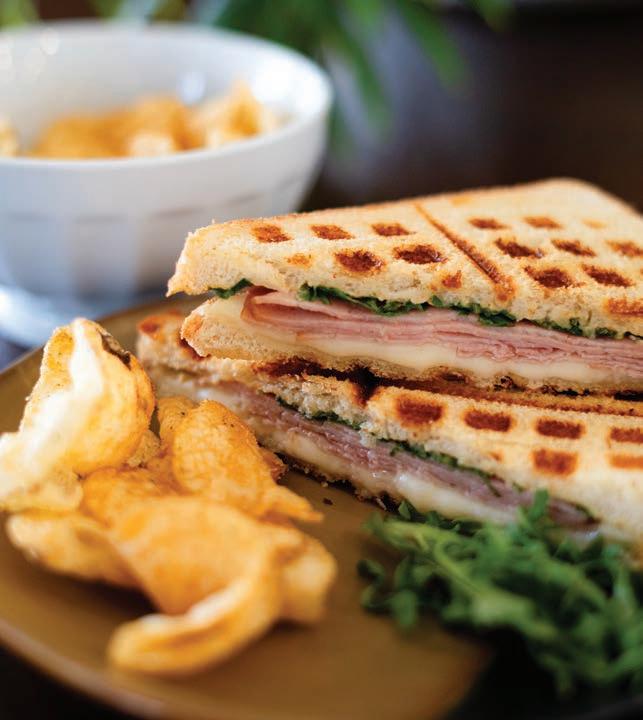
For a grilled cheese that’s perfect every time, try using your waffle iron. Think of it as a panini press, but slightly more versatile. The extra nooks and crannies created by the waffle press are great for dipping in soups. This recipe adds ham and arugula to make it a full meal by itself.
2 slices of bread
2 slices of Swiss cheese
1-2 thin slices of ham
Arugula Mustard Butter
Preheat your waffle iron. Thinly spread one side of each slice of bread with butter. On the unbuttered side of one slice of bread, thinly spread with mustard. Top with one slice of cheese, then ham, arugula and remaining cheese. Place remaining slice of bread, unbuttered side down, on cheese. Place entire sandwich in waffle iron. It won’t close all the way, but don’t press down. (The waffle iron will slowly press the sandwich on its own as it cooks.) Cook for about 3-5 minutes or until bread is brown and toasty, and the cheese is melted. Yield: 1 serving ✦
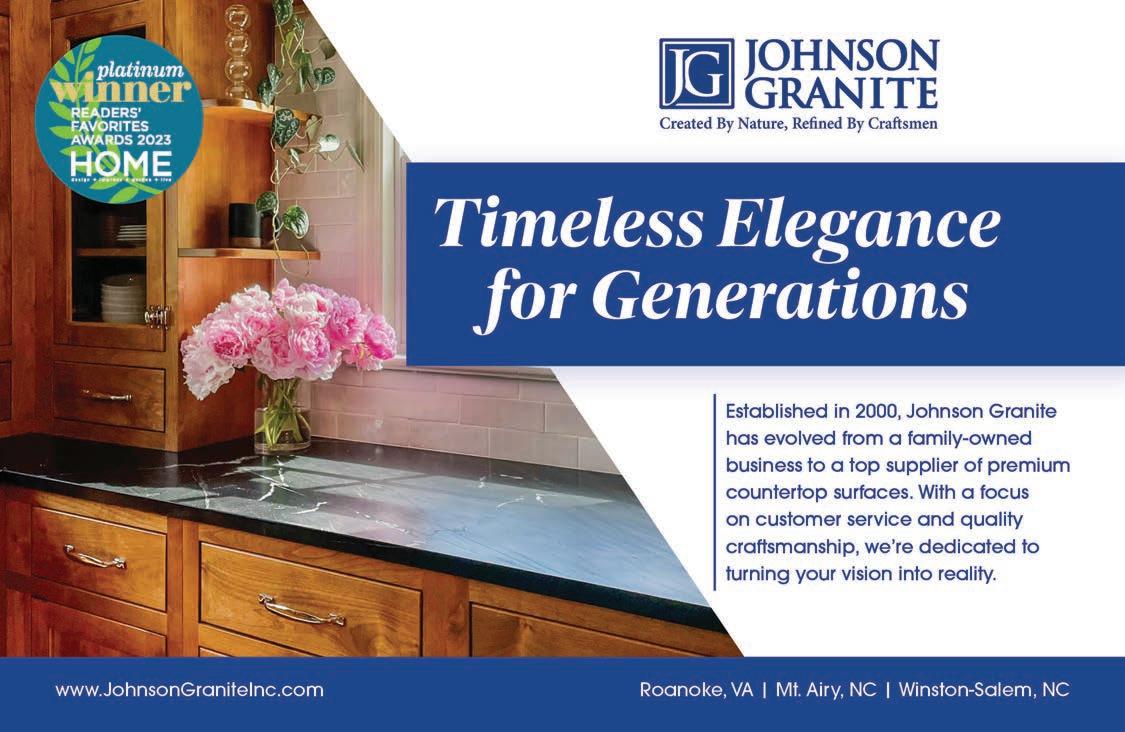
It’s easy to grow your own delicious sprouts year-roundBY SLOANE LUCAS

Crisp salad toppers, sweet crunch in stir fry and fresh zest in sandwiches – all of these can be achieved by adding freshly grown sprouts to your meals. We’ve all seen sprouts for sale at our local grocery store or had them out in restaurants. But did you know how easy it is to grow your own? With minimal investment in low-cost supplies, you can have an endless supply of sprouts at-the-ready, any time of year. Unlike outdoor gardening that depends on seasons, or even indoor gardening that might require special lights or equipment, you can easily grow crunchy, sweet sprouts in your windowsill year-round.
Sprouts are at elevated risk for bacterial growth, so take a few precautions while growing your own. Buy seeds and beans packaged for sprouting use vs. just using beans you have in the cabinet. Sprouting seeds are tested and free of common bacteria. Make sure all jars and lids are clean. Use filtered water when soaking, make sure seeds are draining through the mesh lid, and make sure the lid is well ventilated. Eat them within a week, and if anything looks off or they seem past their prime, toss and grow a new batch.


Not only are sprouts delicious, adding punch and flavor to myriad recipes, but they are also nutritional powerhouses. Different seeds offer various levels of vitamins and minerals — but they often deliver elevated levels of Vitamin K and C, along with magnesium, potassium, phosphorus and folate. They provide fiber and antioxidants and can improve digestion due to enzymes that help break down starch and support gut health.
The only specialty equipment most people will need is a simple mesh-covered lid that can be fitted to a large, wide-mouth mason jar. You can buy these mesh lids online, some of which will also come with a matching dish that will hold the jar upside down to facilitate draining.
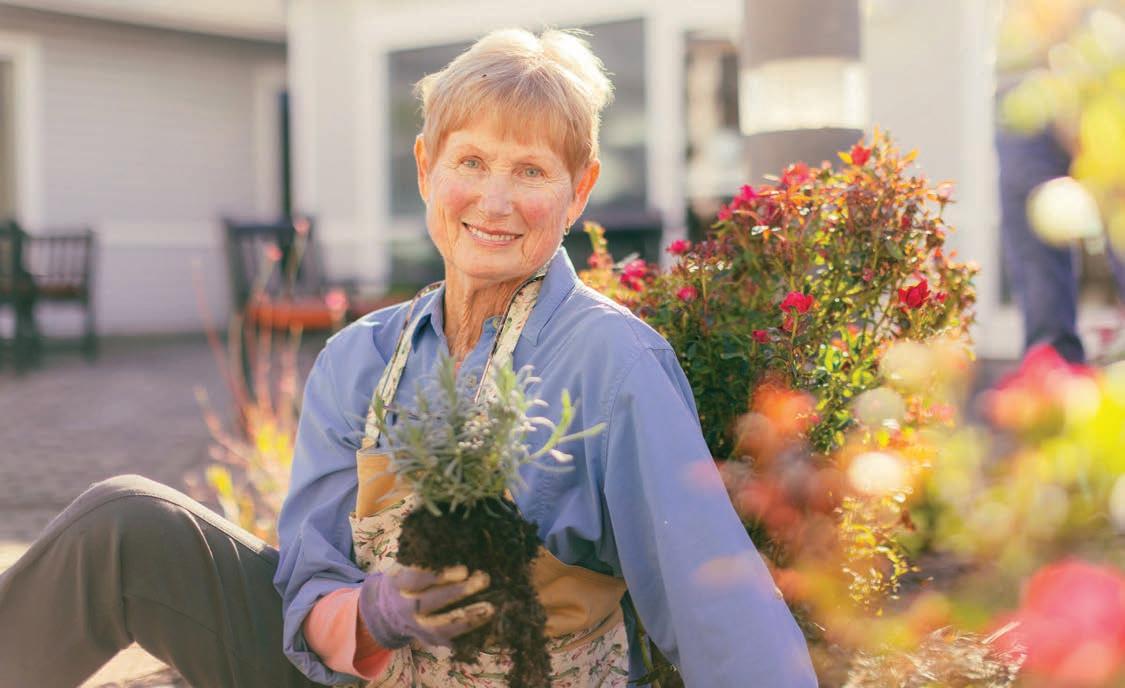


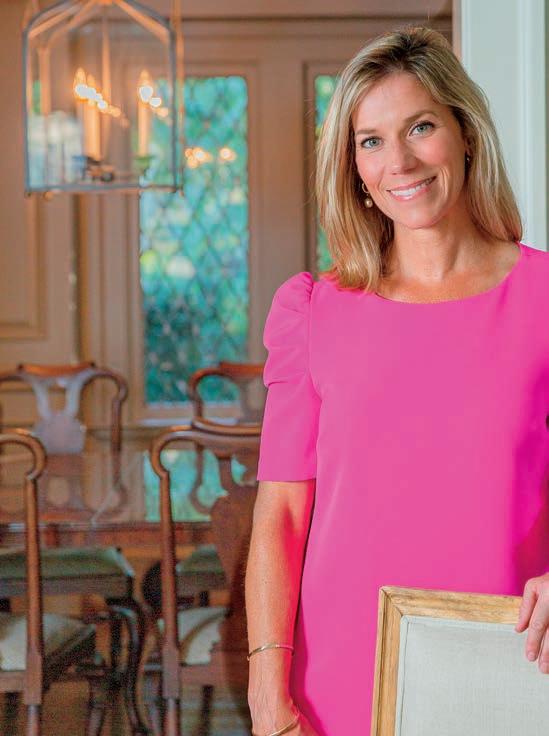






Then, of course, you will need to buy your seeds – and there are so many to choose from. Some of the more popular sprouts are:
n Alfalfa. A mild-tasting variety eaten raw, these are probably the most recognizable sprout, taking three to seven days until ready to eat.
n Broccoli. These are lightly spicy and nutty when eaten raw and are ready to eat in about five days.
n Beet. They taste earthy, just like full-grown beets, and they have pink stems, adding a pop of color to your plate. These take between 11-21 days to reach maturity.
n Chickpeas. They provide more protein than most sprouts. You’ll see green within two days – but they also require longer pre-soaking to start them off.
n Green peas. Tasty and refreshing, these take a little longer to pre-soak, with sprouts ready to harvest in about three days.
n Kale. Nutty and peppery in taste, with streaks of purple, kale sprouts can add flavor and color to your dishes in three to six days. These can be enjoyed raw or cooked.
n Lentils. With even more protein than chickpea sprouts, lentil sprouts can be eaten raw or cooked and are ready in two to four days.
n Mung beans. These are the sprouts we all know and love from some of our favorite Asian stir fries. These hold up well when cooking and are ready to eat in three to four days.
n Mustard. These are ready in three to six days and deliver a little kick like horseradish.
n Radish. With all the different radish seeds available, the sprouts will have some of the same tastes but be milder than their larger full-grown versions. These are ready in three to six days.
n Sunflower. These have more calories than most sprouts but offer a lot of nutty, crunchy goodness. You’ll have to wait between 12-14 days.

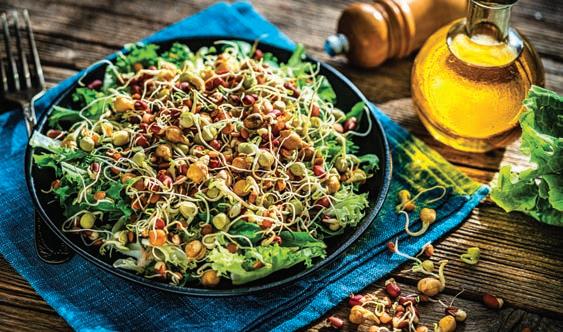
Always read the packaging for specific seeds, but generally sprouts will need the same care to get started and grow. Measure out the appropriate amount of seeds as recommended by the packaging and size of your container, but in general you will be using a small amount of seeds, probably no more than a tablespoon. Even a teaspoon will surprise you with how fast they will grow and fill a large mason jar.
The first stage is to soak sprouts in fresh filtered water overnight. The next morning, drain the water and then rinse with a fresh batch of filtered water. Continue to rinse the sprouts a few times a day. Each time, drain and set the jar upside down to drain water through the mesh cover into a dish or on to paper towels.
You will see seeds begin sprouting in a day or so, depending on which type you are growing. When you are ready to eat them, wash the sprouts in a bowl of water to shake away some of the hulls, which will float to the top. Dry them out on paper towels a bit before storing in the fridge in a lidded container lined with paper towels. Eat them within a week.
Use your crunchy harvest to brighten up salads, add heft and crispness to sandwiches and add extra nutrients to homemade veggie burgers. For sturdier varieties such as mung beans, add them to homemade stir-frys and soups. Or add just a sprinkle to your plate for extra color, flavor and fun. ✦

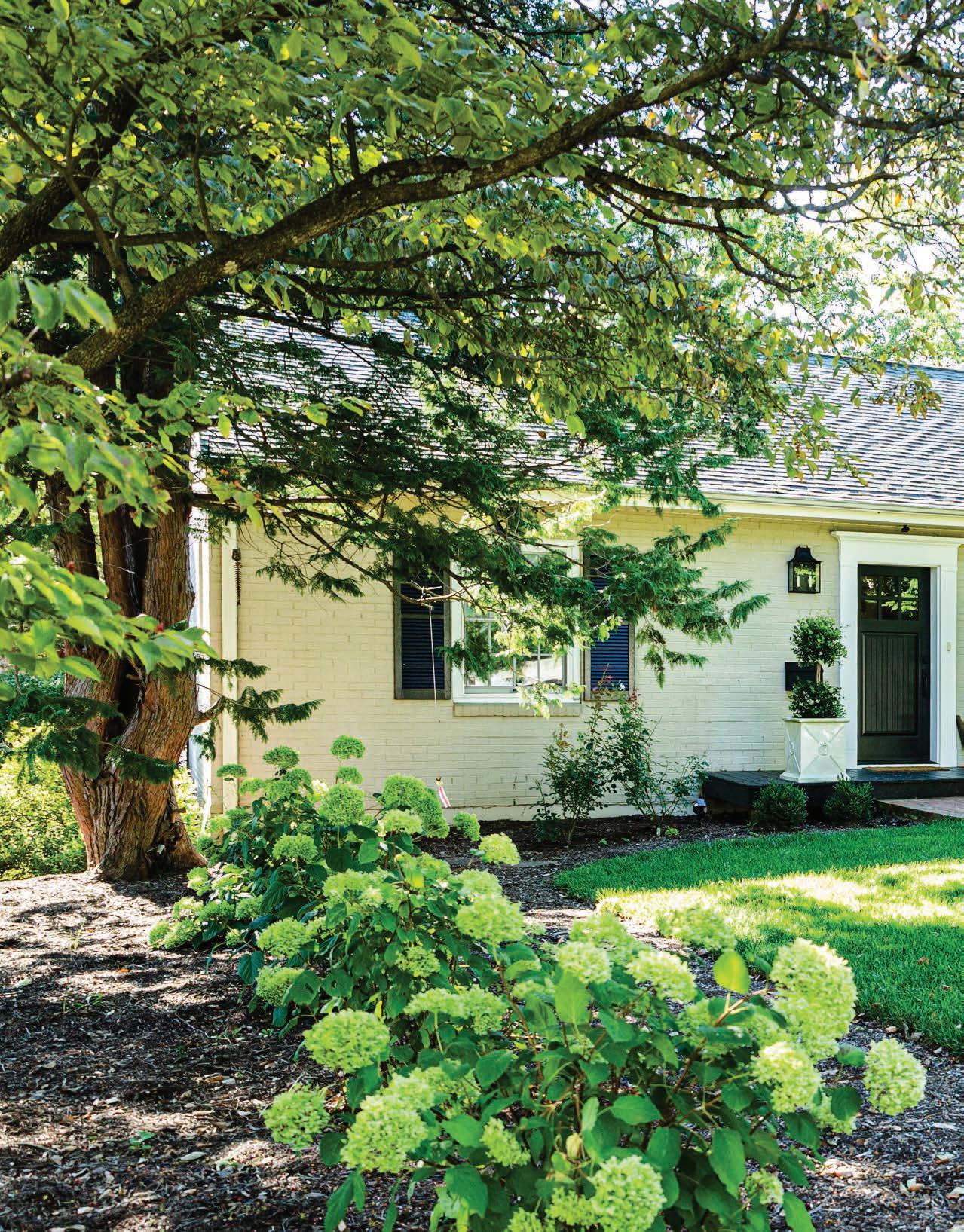

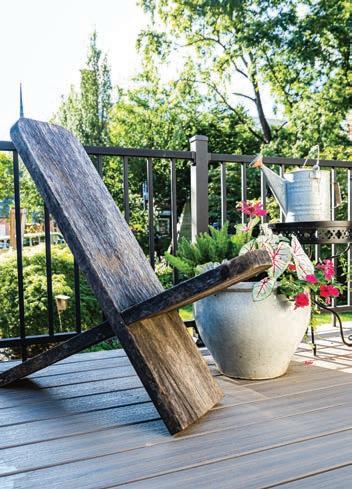
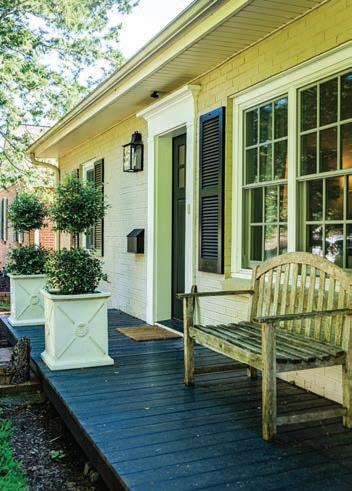


The teal blue bicycle hanging in the front hall sets the tone. This household sustains an active family of four with charm and practicality. Two years ago, Walker and Sarah Taylor realized their family wanted more time outdoors and less home maintenance, so they found the perfect location and downsized from a large two-story colonial to a one-story house with potential. The two old 10-speed bikes they found in the crawl space of this brick ranch home seemed to confirm that they were on the right course. Walker restored them and hung one in the entrance. It is an eye-catching sculpture that complements the colorful art found throughout this well-appointed home.


When the Taylors first purchased the house, it was dark and dated inside, but the garden in the back of the house spoke to Sarah. “There was a Japanese maple out back and ‘come again’ iris blooming in December, so the backyard sold us on this house,” she recalls.
Although the house came with many shortcomings, the Taylors were inspired to design an efficient layout, so they started right away. Walker spent his nights and weekends hard at work on changes he could undertake. He finished the basement to add a family room and turned the fourth bedroom into an office/workout room/art studio. “Every room in this house is multiuse. Our space is small, so all of our rooms have two or three purposes,” Sarah explains.

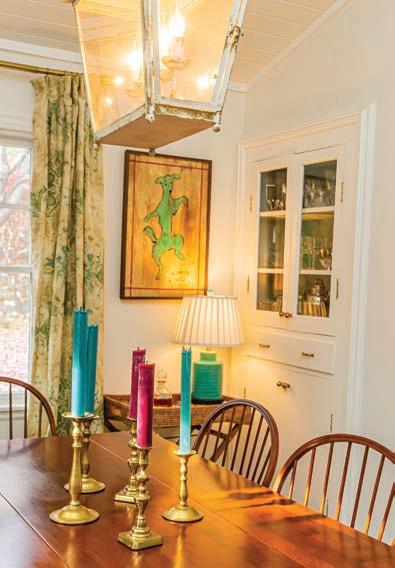
The Taylors hired Pitman Construction to raise the living and dining room ceilings. With the low ceilings removed, white paneled boards angle up to the roof peak, creating more space and brightening the living room. Soft white walls are covered in beautiful art – horses and landscapes add color to the serene white room. Sarah loves horses and collects paintings and drawings of them. Some of their art collection contains pieces from Sarah’s childhood, and others were created by her mother, a local artist.
The high ceiling extends into the dining room where one wall contains built-in cabinets that add character to the room as well as accommodate their collection of lovely dishes and glassware. A white buffed lantern-style chandelier hangs over the dining room table. Everyone wants to be around the table for homework projects, folding laundry and Sunday suppers. It all happens here transitioning easily from one undertaking to another. “The dining room table is a very popular spot in our house,” Sarah declares. Walker notes another good perspective on the multiuse dining room. “You can’t walk away from a mess. You have to put it away.”

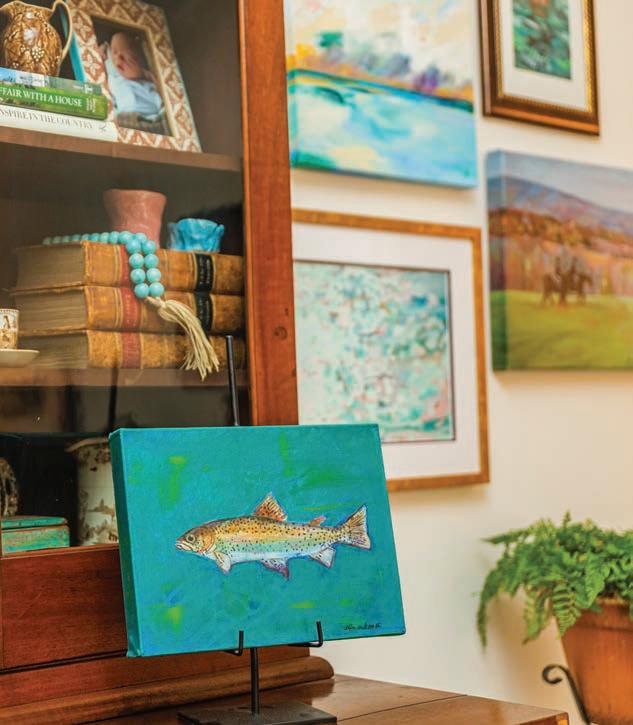



Pitman Construction also renovated the kitchen. White Shaker-style cabinets allow for plenty of storage, and the beautiful brass hardware adds a touch of bling. New modern appliances make cooking family meals easy. Several decorative shelves with scrolled brackets offer space for canisters while the counter below holds a crock of baking tools and offers the perfect place for sandwich making. There is still plenty of room for snowday science experiments; a tray of colorful crystals growing in small dishes was the latest undertaking.
The breakfast nook surrounded by windows provides bright light for Sarah’s collection of houseplants. With the green plant leaves sprouting out of clay pots and a beautiful round antique table and bench, family meals are cheery and cozy. A natural rug and bamboo-style shades bring the outdoors feel into this sunny spot.



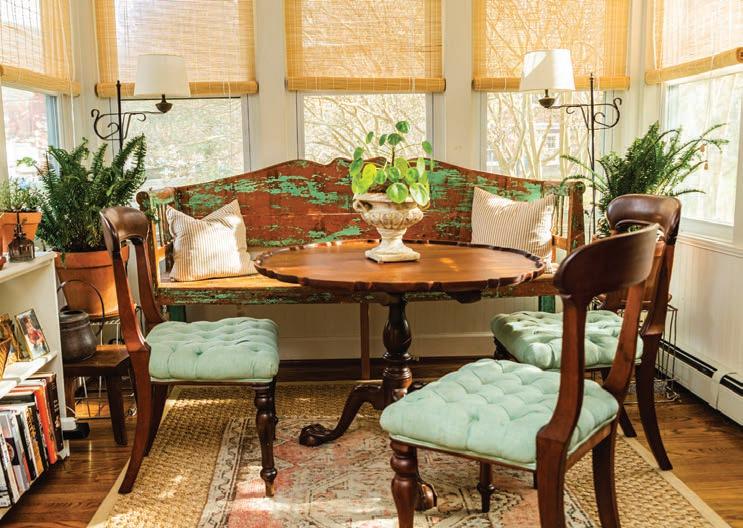

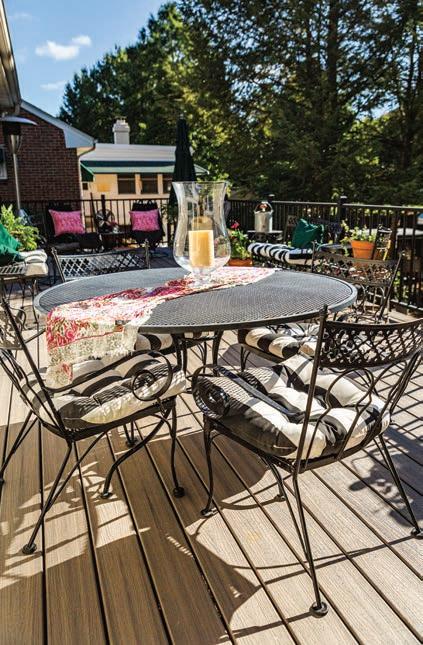
Off the kitchen is a new deck built by Andy Gill, a local contractor who also built the climbing wall out back for their boys. Walker notes that there is “good space utilization back there.” Restructuring the backyard with designated areas for


a garden, climbing wall, deck and a patio made the backyard multifaceted. Everyone has their specific area, yet they are all close. Sarah gardens while one of her sons grows tomatoes. “As a family, we live outside,” Walker explains.





Heading down to the basement family room, Sarah hung the boys’ fishing rods as a purposeful way to store them. They are easy to access for a trip to the river and the wooden rods with metal reels give an artful look, hung on the slanted ceiling.
Creating cozy spaces
In the family room, two sofas provide a welcoming space for an evening of games or lounging during a movie night. Walker has a corner for his office, and Sarah’s office sits just on the other side of the wall. When they built the deck, Sarah wanted more light in her office, so they added tall windows, which give her a straight view out into the backyard under
the raised deck. “Most of the year it is so sunny and green in here,” she mentions. The big expanse of glass really brings the outside inside.
The backyard offers plenty of activity space for their boys. A raised platform with a wooden teepee offers a getaway spot and easy access to their climbing wall and rope exercise equipment. It all functions within the close range of the back deck and offwhite brick patio where the parents can relax with a good book while the boys play and exercise. There is a wooden table and chairs for outside meals when the weather is good, and a fire pit surrounded with chairs offers space to relax with friends and warm hands when it is cold.




The Taylors knew they liked the neighborhood when they chose the house, but once they settled in and started living there, they realized the home’s location was a great bonus. It is close to school and many of their friends and activities. The family finds it easy to ride bikes or walk just about everywhere they go. Sarah’s parents live a few blocks away, so they walk up the street to visit them. The boys can roam a bit – walking to Sweet Donkey Coffee House or Crystal Spring Grocery for a snack. The Greenway is nearby for bike rides, and there are several local neighborhood restaurants that make walking to dinner as a family part of their routine.
“Our house is so close to everything. It really enhanced the way we live,” Sarah says. A smaller footprint means a bigger lifestyle for the Taylor family! ✦



 BY SHELLEY BASINGER
BY SHELLEY BASINGER
As we age, it’s not always easy to embrace the well-known saying, “It’s just like riding a bike.” Especially when it comes to … riding a bike. It’s possible that one, two or even three decades have passed since you balanced on those two wheels.
But there is no reason to be intimidated.
Cycling is actually considered one of the more accessible physical activities.
“Cycling is really for everyone. Children can learn to ride a balance bike as soon as they can walk, and adults can ride their entire life,” says Karen Mead of Cardinal Bicycle in Roanoke.
For those who are interested in the world of cycling and want to know how to get started, Mead helps us break down the basics.
First and foremost, you need to decide which type of cycling you want to pursue. Ask yourself a few questions:
n Do you want to ride on trails or on a flat surface/road?
n What’s available where you live?
n Which option makes you feel more comfortable?
Once you answer these questions, you can start doing your research on a bike.
Pick a bike … but not just any bike
Newbies should understand that any bike is able to ride on the road — but a road-specific bike is going to be faster and more tailored to that environment.
The main visual difference is the tires. Mountain bike tires are wider, larger and have more pronounced tread to navigate uneven trail terrain. Road bike tires are more narrow, allowing beginner cyclists to maintain an average speed between 10 and 14 miles per hour.
While we all want to save a few pennies, Mead highly recommends buying a bike from a reputable bike shop, so you end up with a piece of equipment that’s the best fit for you.
“Your local bike shop also uses professional bike mechanics to assemble and maintain your bike. Big box stores do not have this level of service, and these bikes usually need a visit to your local shop to get them working properly, and in some cases to make them safe to ride,” says Mead.

If you go to a local bike shop, you can find a bike that’s the right frame size for your stature. Then, staff will adjust the seat height and other settings for you to make sure you are comfortable.
Mead says used bikes can be an option; they sell both at Cardinal Bicycle.
“A used bike will have already experienced some wear and tear,” Mead explains. “The used bikes we sell have been fully serviced, tuned up and are ready to ride. If you are buying a used bike from an individual, ask about the bike’s recent service history, or ask your bike shop to look at the bike before you buy it.”
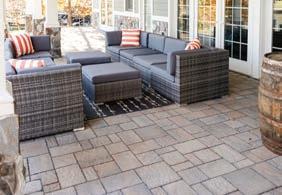





The one essential piece of gear Mead says any cyclist needs is a helmet.
Virginia does not have a state-level bicycle helmet law but allows localities to set requirements by local ordinance. In the Roanoke Valley region, helmets are required in Roanoke, Salem, Blacksburg, Radford and Christiansburg.
“You should also have a way to carry water and a few basic repair tools to include a spare tube, an inflation tool and a multi tool,” she says, adding that even if you don’t know how to change a flat tire, it’s good to have this on hand when someone stops to help you.
For clothing, she says new riders should wear whatever they are comfortable in.
“As you ride more, the first piece of clothing that can really improve your comfort is a high-quality pair of bike shorts. Cycling-specific shoes can also dramatically improve comfort — even for short rides. Cycling shoes are much stiffer and provide better support when your feet are on the pedals,” she says.
Other gear suggestions are gloves, protective eyewear and padded shorts to help provide some cushion.
Beginner cyclists will want to tread lightly (no pun intended) and start out on an easy path or trail.
For road cyclists, Mead says a lot of new riders enjoy the Roanoke River Greenway.


“It’s flat and away from cars,” she says. “Cyclists on the Greenway should maintain a safe speed (not too fast), alert other riders when passing, and give enough space when passing other users. If you need to stop during your ride, pull off to the side so you do not block other trail users.”
The most popular places to mountain bike in the area include Mill Mountain and Carvins Cove.
Here are a few of Mead’s rules/best practices to keep in mind when mountain biking:
n Riders going downhill should yield to uphill riders.
n Cyclists should also yield to all other trail users, such as pedestrians and horses.
n Pedestrians will often yield to a cyclist. “When they do, be sure to slow down and thank them,” she says.
Whichever cycling path you take, Mead says if you stick with it, cycling can become a lifelong passion.
“Everyone will get something slightly different out of their cycling experience. Many riders value the community, sense of accomplishment, and ability to explore new places,” she says. “It can change your life.”
The Roanoke area offers numerous cycling clubs. Learn more at roanokeoutside.com/guides-and-gear/find-groups/biking-groups/ ✦









Maybe you have it all mapped out: a home gym over here and a game area over there. You’re ready to make your home’s catch-all space, otherwise known as your basement, a comfortable living area to enjoy with family and friends. If you want to take full advantage of the extra square footage down below, here are some ideas to get started.

When we start to outgrow our home, the first thing we may consider is an addition. But this can be expensive, lengthy and cause us to sacrifice a large part of our yard. A basement remodel can be an affordable way to make the most of existing space.
A 2022 Remodeling Impact Report from the National Association of Realtors (NAR) and the National Association of the Remodeling Industry (NARI), estimated ROI for finishing a basement is 86 percent of the project cost.
Refinishing a basement was identified by Houzz as one of the top emerging trends in home improvement, based on data from the online searches of homeowners, contractors and designers in its summer 2023 report. “Online searches for ‘finishing a basement’ have increased significantly over the past year as more homeowners look to turn their large, open spaces into a family or recreation room,” it reads.
Basement remodels ranked higher than seven other projects, including kitchen and bathroom renovations. Searches were up by more than 100 percent for “basement movie theater,” more than 500 percent for “basement rec room,” and nearly 800 percent for “basement family room.”



Before you start, you’ll want to tackle any water issues, correct humidity levels and conduct radon testing. If you’ve ever had water in your basement, you will want to call a local foundation expert to assess the problem and get long-term solutions. There’s nothing worse than laying a new floor and finding puddles the day after a big storm. Make sure you have a secure gutter system that you can keep clean year-round and proper drains that take rainwater away from the house. Basement waterproofing experts always suggest running a dehumidifier to automatically keep humidity levels steady and prevent mold, mildew and that musty basement smell. There are many energyefficient models that can be connected with a sump pump system or its own drain system so you don’t have to manually dump out the water every day. The Virginia Department of Health recommends you conduct radon testing on “every section of the home that is in contact with the ground.” (The highest radon levels are typically found in the lowest livable space of a structure.) The department regularly offers discount radon test kits, but area professionals can do this for a cost of $100-$200.
Most basements have exposed support posts. Made of steel, the unsightly posts just hang out in the middle of the room. Many homeowners are finding creative ways to dress these up. Column wrap designs are available in white PVC, wood and stone. Even just wrapping it in nautical rope can create a finished look. One idea to pull the posts into your design is to build a half wall between a main wall and the post, sectioning off an area of your basement and using it for the back of a couch or even topping it to make a bar area.









Imagine the possibilities
Want to build out your basement to its potential? Try these ideas and tips:
FAMILY TIME: Turn your basement into a true family room, a place to watch TV and play games. Sectionals work great, with plenty of space for everyone to lounge. Add a kitchenette (or even just a mini fridge, freestanding cabinet or cart) for quick snacks.
n Tip: Install recessed lighting to give the illusion of higher ceilings. If you don’t have any windows or if your basement isn’t a walk-out, keep the palette white and bright to make up for the lack of natural light.
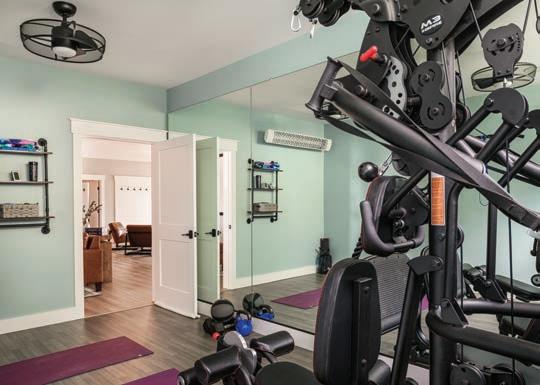
WORKOUT AREA: You don’t need a lot of equipment to create a home gym — at least one cardio machine (a treadmill or stationary bike), a set of dumbbells and a yoga mat. Flooring is important; foam tiles or rubber mats are fairly inexpensive and can be placed right over concrete.
n Tips: Use hooks for towels and install sturdy shelves for equipment and even a special holder for your water bottle. A regular pegboard can provide a place for exercise bands, jump ropes and yoga mats. Add floor-to-ceiling mirrors for an upscale look, to help you better gauge your progress and to give the illusion of a larger workout space.

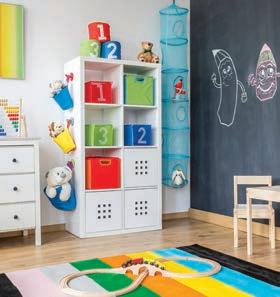
HOME OFFICE: Many people build a home office in the basement for more privacy and less noise. The area under your stairwell could be the perfect office nook or at least provide storage space for books and supplies.
n Tip: Use a combination of task lighting and ambient lighting to make a comfortable working environment.
FOR THE KIDS: Add plenty of shelves and bins. Keep it colorful. Use bright colors on the walls, add a mural and use a fun kids’ rug or colored foam floor tiles.
n Tips: For those mandatory quiet times, incorporate a reading nook (under the stairwell could be the perfect hideaway). If you have the clearance overhead, you can add a small indoor gym center (search “kids indoor gym” online for ideas), a welcome attraction on rainy days.

SWEET SUITE: If you have the space, you could convert your basement into a studio apartment to rent out or to use for family members, perhaps a grown child who is trying to save some money or aging parents who need assistance. If you have an easily accessible walk-out basement, remodeling a space for them could save you money and keep them close by.
n Tips: Reconfigure the space and add walls or room dividers to make a bedroom, kitchen or living area. Check with local building codes for basement bedrooms (many areas call for two egresses with a door or window to the outside).



For one local couple, an empty landing space between the garage entrance and the first floor begged for attention. The unfinished basement area had exposed joists above, concrete floors below, cinder block walls and unsightly single-bulb light fixtures. Walking past it every day, they wondered how they could liven up this stark, cold space and make it a welcoming spot for guests. That’s when they turned to one of their shared interests — wine — and the idea of a wine cellar was born.
The unfinished space included a 4-by-7-foot alcove off the landing, which proved to be a perfect place to both store and display their wine collection. They decided to encase the whole alcove in glass to really make it a showcase. They called on a local contractor to help design and hang the wine racks and install the glass doors. A cooling unit was added to keep the area at a constant temperature.
Then the question was what to do with the stair landing outside the new glass cellar, a rather large space (14 by 8 feet). Immediately, they knew they wanted to create a warm space where they could spend time with friends and family exploring the world of wine. The space could be used to lounge, to entertain, hold wine tastings and even just converse about their wine hobby and travels. They describe the design as “straightforward,” but with the flexibility for a wine tasting for up to six guests.

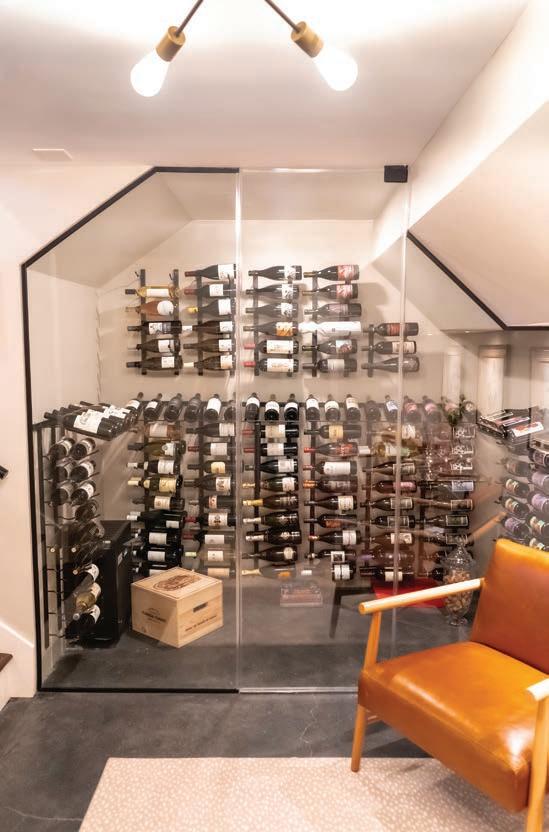
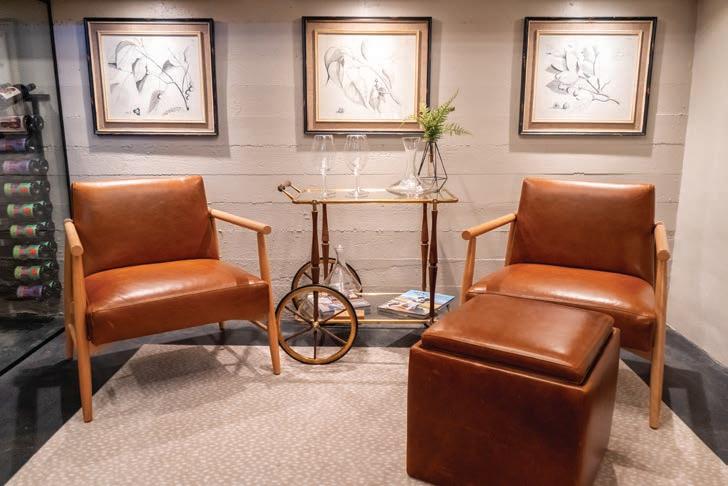
They finished the ceiling with drywall but decided to keep the concrete floors and cinder block walls to maintain the true cellar feel. They dressed up the space with dark concrete stain on the floors and light paint on the walls. They did some of the work themselves, but they also supported many local vendors and crafters. The chairs and ottoman were custom built locally using leather from another local crafter. They rescued a classy glass bar cart

with gold accents from a local architectural salvage store and stocked it with wine glasses. The finishing touches included elegant artwork, a rug and modern light fixtures all set with dimmer switches to change the mood any time they want.
With a little creativity, these local homeowners transformed a dreary, neglected space into a happy place to explore a hobby and entertain in a fun way. ✦










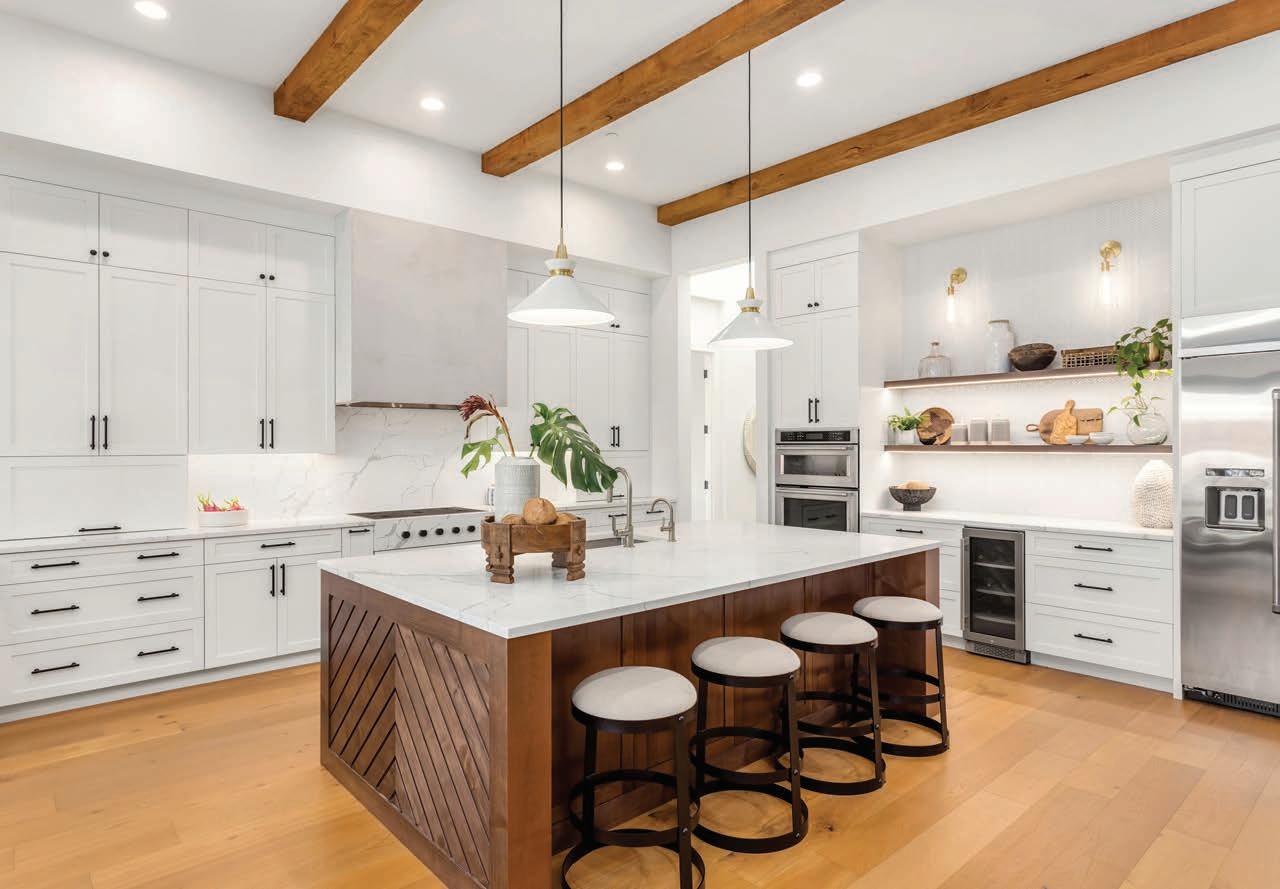
Who doesn’t dream of a photoshoot-worthy kitchen? You know the type: one with ample and easy-care counter space, tons of storage in handsome cabinetry, an abundance of natural light, tough but beautiful flooring, plus an array of appliances, both large and small, designed to make every kitchen task a snap. Welcome to the worldwide club of dreamers! Fortunately, even if a total kitchen remodel isn’t in your budget, you can harness the burst of energy that comes with springtime and upgrade the hardest-working room in your house by simply decluttering your kitchen countertops.

Appliance garages to the rescue!
Move toward the streamlined kitchen of your dreams by corralling appliances such as microwaves, blenders, stand/hand mixers, coffee makers, toasters and air fryers behind closed doors in a dedicated storage cabinet known in HGTV-speak as an appliance garage. Not only are these so-called garages useful in decluttering countertops, but they also provide storage for rarely used and seasonal items. (Crockpots and Christmas dishes deserve dedicated storage space, too.)
Assess first
Answers to these questions will help determine which kind of kitchen garage(s) will work best for you:
n How many and what kind of kitchen appliances do you have that could be stowed out of sight?
n What sizes and how heavy are they?

n What height should they be stored? Would they benefit from being countertop height so they can simply be slid out onto the counter in front of the garage or left on a top shelf only to be taken down on special occasions?
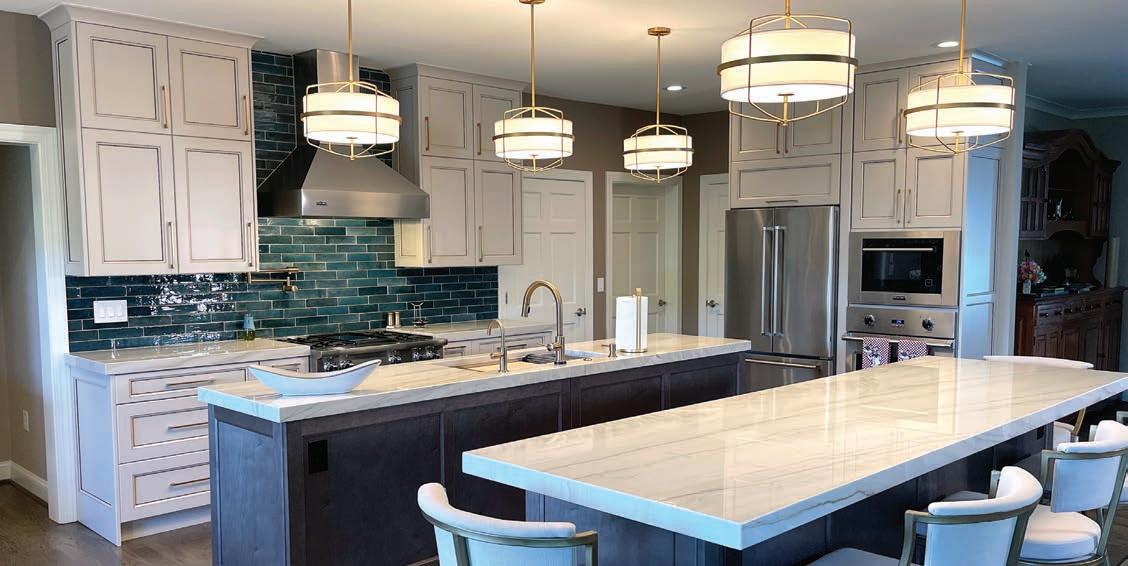
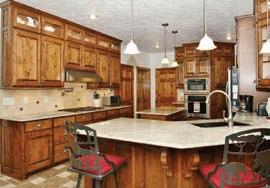








After you’ve assessed how many and what types of appliances you want to conceal, the next step is to examine closely the layout of your kitchen and the look of your existing cabinetry. Will you need to hire a contractor to custom build your appliance garage to match your existing cabinets or will you purchase a ready-made solution in a contrasting color and/or coordinating design? Sometimes an underutilized countertop corner can be the perfect place for a purchased appliance garage that will simply slide back into that corner under existing wall-hung cabinets. When adequate in size, a purchased appliance garage can be a handy spot to conceal a microwave or other heat-producing appliances while allowing for proper ventilation. Whether you choose to add an undercounter unit or build a much larger appliance garage, your kitchen layout will drive the design.
It’s all about the doors
For maximum functionality of any appliance garage, the type of doors you choose is critical. In most cases this means being creative when it comes to making doors “disappear.” Below are some ways to achieve this.
Roll-up doors, also known as tambour doors, are made of connected narrow slats that roll back into the upper or lower area of the specialty cabinet with the help of a handle, perfect for appliance garages that house larger, heat-generating appliances that will be used in place. An added benefit of tambour doors is that they will never be in the way of adjacent cabinets and other workspaces.
Another solution is to use doors that swing open and then slide back into the cabinet on either side. This design requires adequate space on either side to accommodate the rollbacks and is often used when an entire wall-hung cabinet is being transformed into a multi-tiered appliance garage. An additional plus of rollback doors is that they close by simply pulling them back out fully and then closing them just like standard cabinet doors.
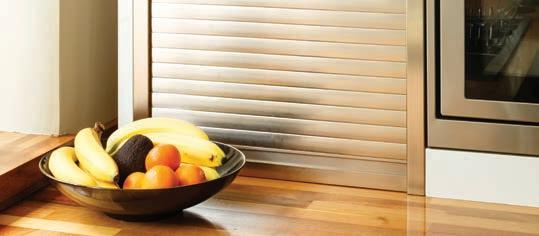

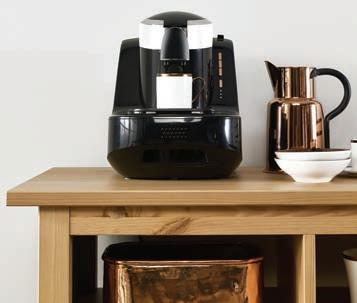
Sometimes all you need is a strategically placed beverage station. Why not add a countertop model or dedicate an existing cabinet to a coffee maker/hot water pot, along with an assortment of coffees, teas, packets of hot cocoa and cider mixes, plus creamers, sweeteners, stirrers and mugs? A simple beverage station like this can streamline traffic flow at busy food prep times.
Especially in smaller kitchens, a great choice of doors is one that either pulls down or lifts up. One of the benefits of a door that swings down is that the door provides a landing area for associated items.
For heavy items that are most conveniently used at counter height, consider lifts installed inside base cabinets. Placing large appliances such as food processors and stand mixers on lifts inside base cabinets provides relief from moving heavy objects. At the same time it frees up valuable counter space and allows associated items to be stored on a shelf underneath.
Remember to add sufficient electrical outlets and lighting inside garages. In cases when you can’t match your existing cabinetry, consider a door with an insert of perforated tin, caning or a metal grille to make the door look more intentional. A customized kitchen appliance garage will not only conceal counter clutter, but it will also enhance the functionality of the hub of your home, getting you one step closer to your dream kitchen. ✦




Just as every structure needs a solid foundation, your home’s interior design needs an anchor to create stability and durability. Certain high-quality items will set the stage and are worth investing in, even as your décor evolves over time. So where does a homeowner begin? Think about three S’s: splurge, save and sustainability.

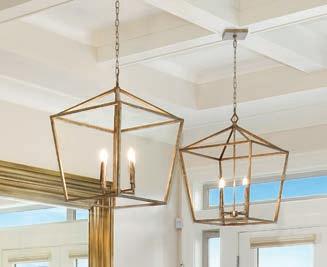

Let’s start with those splurge-worthy anchors.
SOFA — A sofa is a major focal point in a living space. It is where guests gather and families relax. Since seating is generally used more than any other element in the home, it is worth investing in the highest quality sofa you can afford. The weight of the piece is an easy indication of quality. Sofas made with plywood or particle board won’t last. A sturdy frame made with quality hardwood, frame joints that have been wood glued and dowelled, premium cushion filling and quality spring units are elements of a high quality sofa. Consider investing as well in a performance fabric, an easy-to-clean option that wicks away stains.
STATEMENT LIGHT FIXTURE — A dazzling chandelier or pendant lighting can immediately elevate the look of everything in the room. Think of scale — the larger the better, especially with chandeliers. Dimmable chandeliers and pendant lights made from high-quality materials such as crystal, Murano glass, premium metals like brass or gold, and fine woods tend to be more expensive, but will last forever.
RUG A beautiful rug is a foundational layer that can make the rest of your room pop. With rugs, it is worth splurging on size. Investing in a bigger rug is always a good idea; the bigger the rug, the larger your room can feel. Rugs should either have two legs of the furniture on them or all of the legs. The cost of rugs depends on construction, materials and size. A handmade rug is something to consider if you are looking for a unique rug to be a family heirloom. High-end rugs are made of natural materials such as wool or silk and have high-weave density. Not all luxury rugs need to be hand woven. Modern rugs made of wool blended materials can be just as visually stunning.
ART — A piece of original art immediately makes your interior unique, as a viewer sees something not found anywhere else. When displayed in your home, original art can change the feeling one experiences in that room, making it more comforting and personal. Art can also tell a story — where you traveled to find it, what color palette speaks to you or simply a reminder of a place you love.


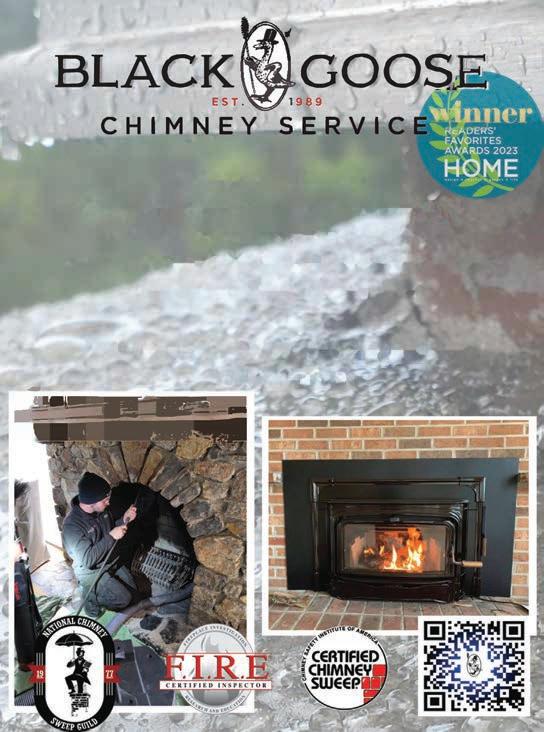


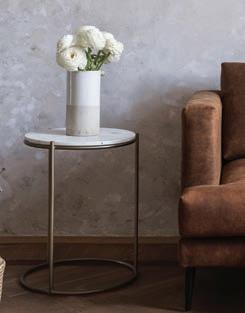
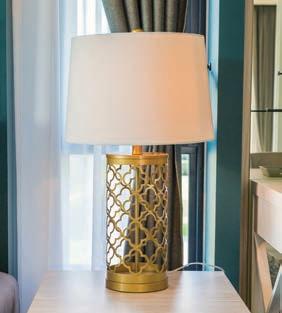
Save
In the save category are items that are essential in your décor, but where you may find some bargains and still have the opportunity to create a unique style.
SIDE TABLES — Side tables are highly functional, serving as a place to set down a drink or book. They complement larger pieces of furniture and are a good place to get away with going lower-end.
CONSOLES — These are generally decorative and don’t experience wear and tear, so thinking less about durability and more on style is an opportunity to save. Console tables typically have an airy design with only small drawers and open shelves.
COFFEE TABLES — Generally made of one or two solid materials means you can get away with saving on these. Coffee tables are a great place to dress up with some beautiful accessories such as a piece of art, a bowl or some beautiful books.
LAMPS — Decorative table lamps and bedside lamps need not break the bank. Stylish and affordable lamps are available at a variety of price points and can be switched out easily as trends change.
RUGS FOR HIGH TRAFFIC AREAS — Entryway rugs or kitchen runners that are easy to clean are the best choices for these areas. Rugs made from man-made materials such as nylon or polypropylene are some of the most common rug types on the market. They are made to withstand heavy foot traffic, are easy to clean and stain resistant. Best of all, they are very affordable. Stay away from jute or sisal which are difficult to clean.

Characteristics of sustainable furniture
n Recycled or salvaged content (wood, plastics, metals)
n No- or low-VOC levels (volatile organic compounds that emit gases into the air)
n Rapidly renewable or bio-based materials
Sustainability is an emerging trend in furniture production practices. Studies have shown that creating products of high quality and built to last can have significant environmental benefits. Keeping cheaply made furniture out of landfills is a growing concern among customers, especially younger ones. According to the EPA, furniture waste generated by Americans in 2017 totaled a staggering 12.2 million tons, and 80.2 percent of it went to a landfill. To respond to this demand, a growing number of companies are participating in green initiatives and adapting their manufacturing processes. Some offer options to buy back or trade in furniture.
Some companies now offer furniture buyback programs. Others repurpose and upcycle, allowing worn pieces to get a second life. A number of vintage markets and companies in our area offer upcycled and antique furniture. Check out Black Dog Salvage or TXTUR in Roanoke, Estates Revisited in Lynchburg, or Virginia Found Goods in Hurt, to name a few. ✦
n Recyclability, including packaging
n Environmentally preferable supply chain and manufacturing processes
n Ability to be modified or reconfigured


The 2024 Historic Garden Week in Roanoke features four private homes and gardens in Lakewood, a lovely neighborhood that has not been featured in more than 40 years. This hidden gem of a community offers varied architectural styles and gardens. The tour starts at the Community Garden at Virginia Western where complimentary parking is available and courtesy shuttles will transport guests to Lakewood, where they can walk to visit the homes and gardens.
Owners: Meredith & John Draper
The current homeowners purchased this 1952 whitebrick colonial in 2012 and knew it was the ideal home and neighborhood for their busy family. Upon purchase, the Drapers completed a 3,800-square-foot addition that included a kitchen/family room, a main-level primary suite, a laundry room, half bath, exterior porches and an in-ground pool. The addition, while not compromising the traditional architecture of the home, allowed for a modern family of five to have all of the space and comfort they needed. Meredith is a consummate designer and admittedly loves to collect pieces of art, furniture and accessories and then figure out how they will work together. The home is a testament to the collected stories of the family’s life.
Owners: Dr. David & Leslie Wyatt
As the original residence in the Lakewood neighborhood, this property has been evolving since Ernest Fishburn purchased it in 1913. Intended to be a hunting retreat to escape downtown Roanoke, the Fishburn family built a small log cabin, which has been repurposed as a guest house. The main residence was built in 1952 as the surrounding community grew. The English cottage-style home sits on a garden property characterized by more than 200 mature boxwood bushes, trees of multiple species, original rock wall terraces and recently refurbished water features and walking paths. In 2021, the current owners added an in-ground pool and an outdoor entertaining space. The interior design of the house features a mixture of antique, traditional, mid-century and modern pieces.
Owners: Mary Lynn Wright & Joe Alesantrino
This spectacular 1927 English-style, stucco home is one of the original structures in this quaint neighborhood. Set on 1.5 acres of lawn and gardens, the property includes a serpentine wall, slate garden paths, an in-ground pool with an outdoor entertainment area and countless trees and flowering plants. A potting shed, original to the property, sits adjacent to a “Peter Rabbit Garden” and houses a collection of antique glass bottles found on the property during renovation. The current owners purchased the house in 2019 and began an extensive restoration, renovation and addition. While remaining true to the historical aspects of the house, they modernized it to suit their blended family and accommodate both casual and formal entertaining. The decorating style is warm, colorful and eclectic.
ROANOKE TOUR
Saturday April 27, 2024
10 a.m. to 4 p.m.
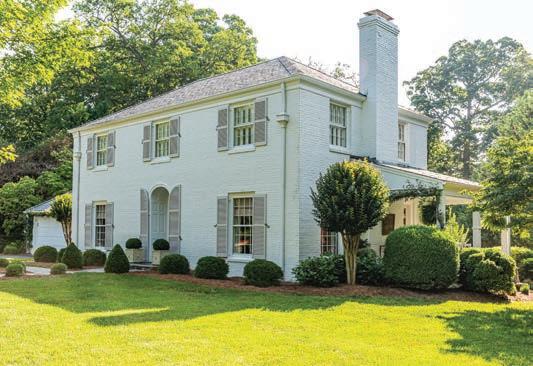



Owners: Reagan & Joe Thielecke
When the Thieleckes were considering the perfect home in which to raise their young family, Joe knew exactly the right house and neighborhood. He loved growing up in this 1953 rambling ranch set on more than 2 acres of lawn, garden and woods. When his mother was ready to downsize, the young Thieleckes jumped on the opportunity to bring the next generation to this special home. This custom-built ranch was designed by the original owners to mimic the “Florida homes” they had seen on vacation and come to love. A dramatic entryway and formal living room reflect the mid-century design of the home, but open into a modern, family-friendly kitchen and den. The contemporary art throughout the home is the work of homeowner, Reagan, and her mother, Janine McGuire, a professional artist based in Baltimore, Maryland.

The Community Arboretum at Virginia Western Community College is a 2-acre educational, multi-garden space. The area includes 11 separate gardens and plant collections surrounding a centrally-located amphitheater. The Arboretum is home to more than 700 labeled plant species. The garden area includes a Children’s Garden with a maze and plant zoo, a Sensory Garden, a Shade Garden, native plants and a City Garden, which includes sustainable features such as rainwater collection systems and drip irrigation. Master Gardeners and VWCC students will be available throughout the day of the tour to provide information about the plantings and activities at the Arboretum.
Tickets are available online at vagardenweek.org and at Townside Gardens: $30 in advance. Day of the tour: $40 and available only at Garden Tour Headquarters located behind the Arboretum, Virginia Western Community College. ✦


Proceeds fund the restoration of Virginia’s historic public gardens & landmarks Roanoke Tour
Saturday, April 27, 2024 10am – 4pm
TICKETS AVAILABLE AT www.vagardenweek.org and at Townside Gardens 3614 Franklin Road, SW
The Beloved Annual Statewide House & Garden Tour



Purchasing a home can be intimidating for first-time buyers, but you don't have to do it alone. Our team of experts is on your side from contract to closing and beyond. We'll help you secure the financing you need, so that you can focus on making yourself at home.
CHOOSE A TEAM YOU CAN TRUST.